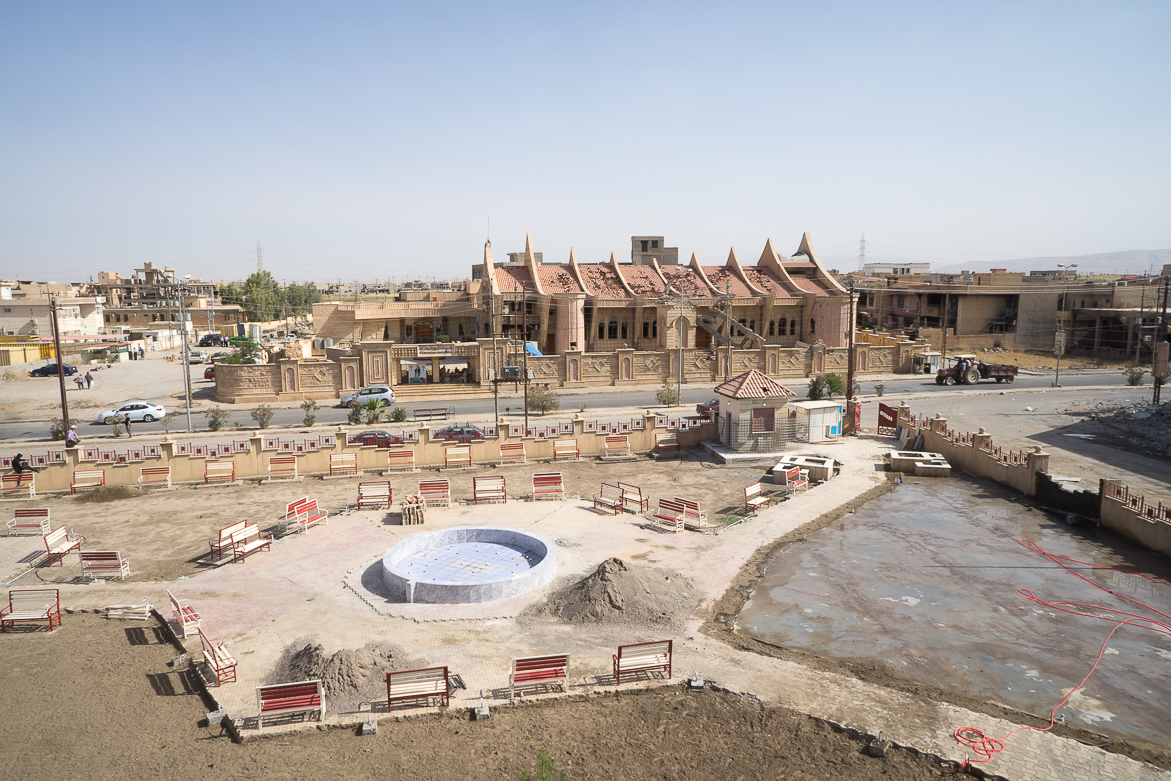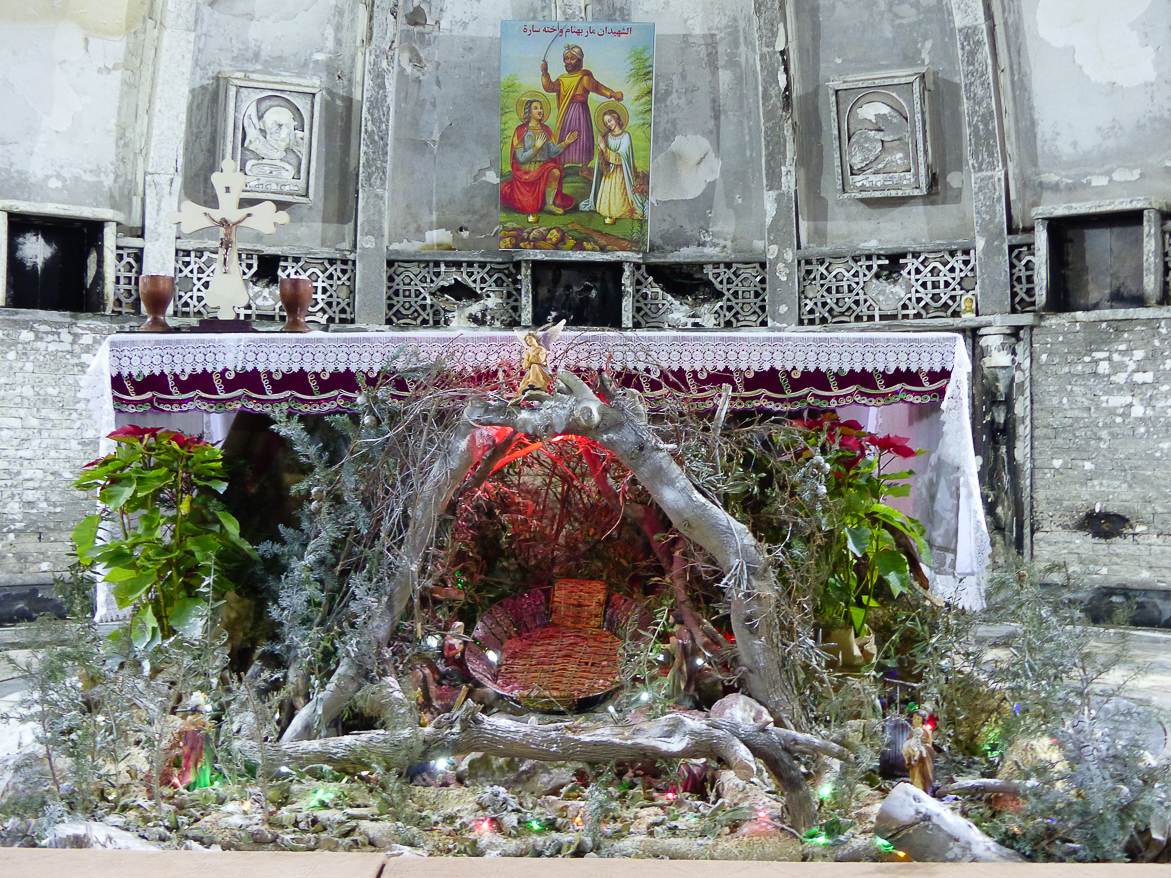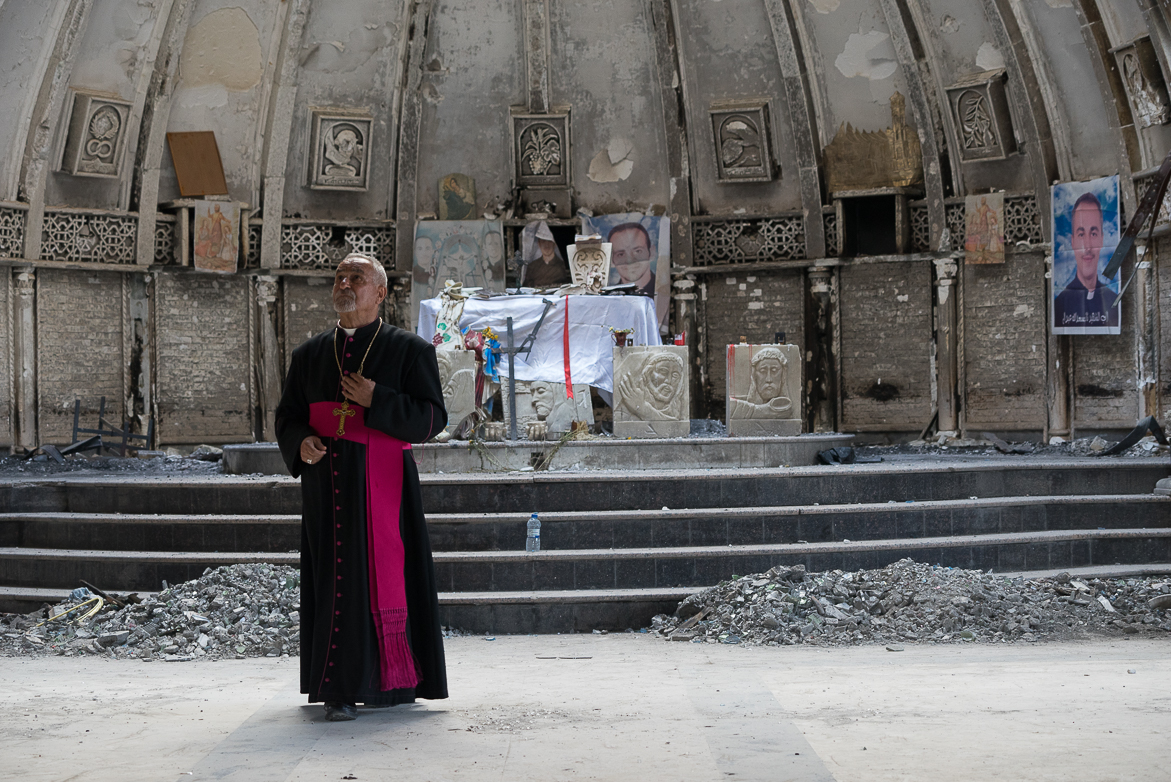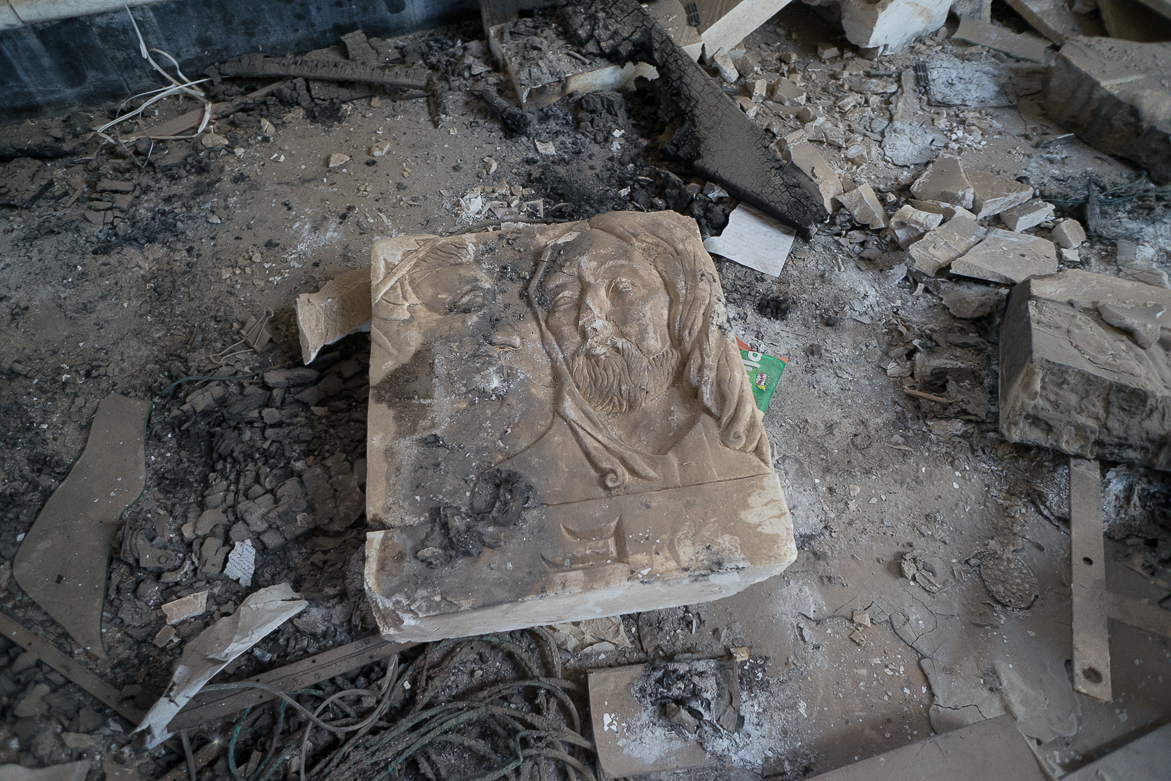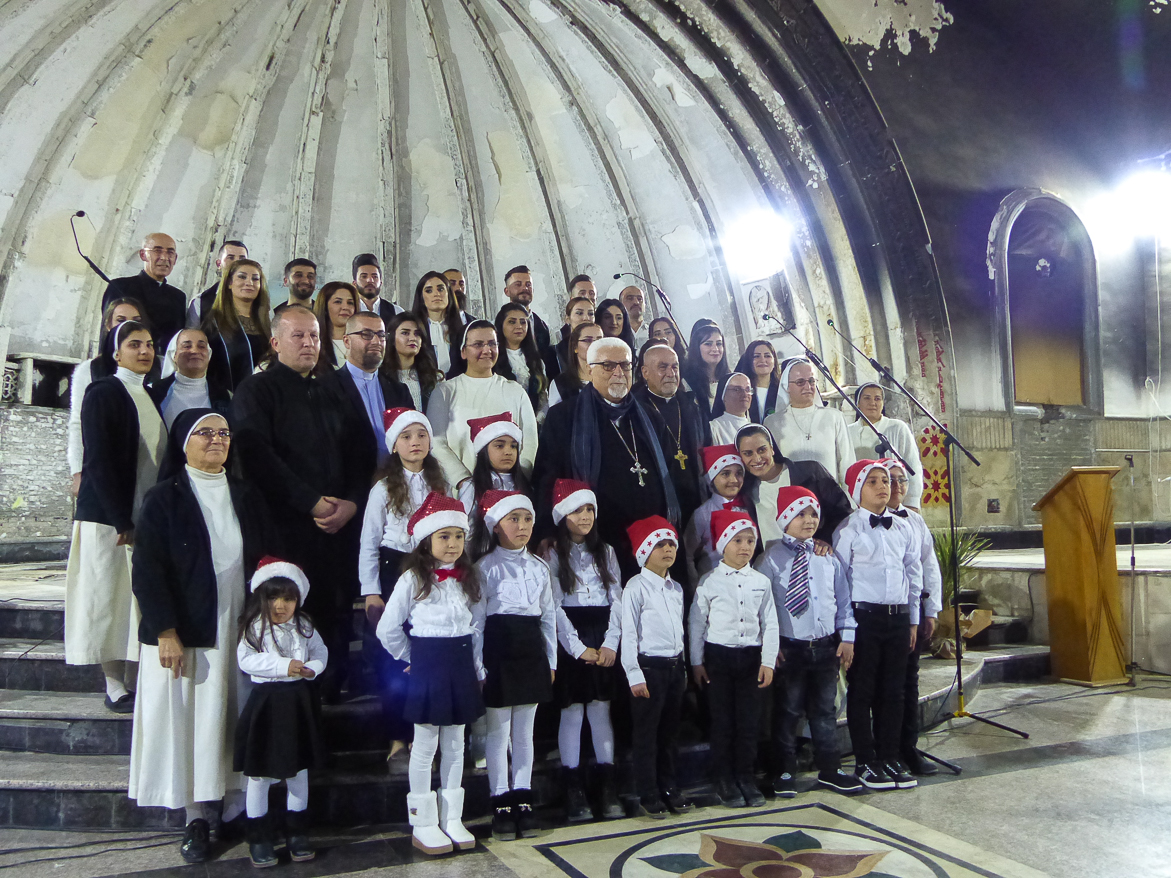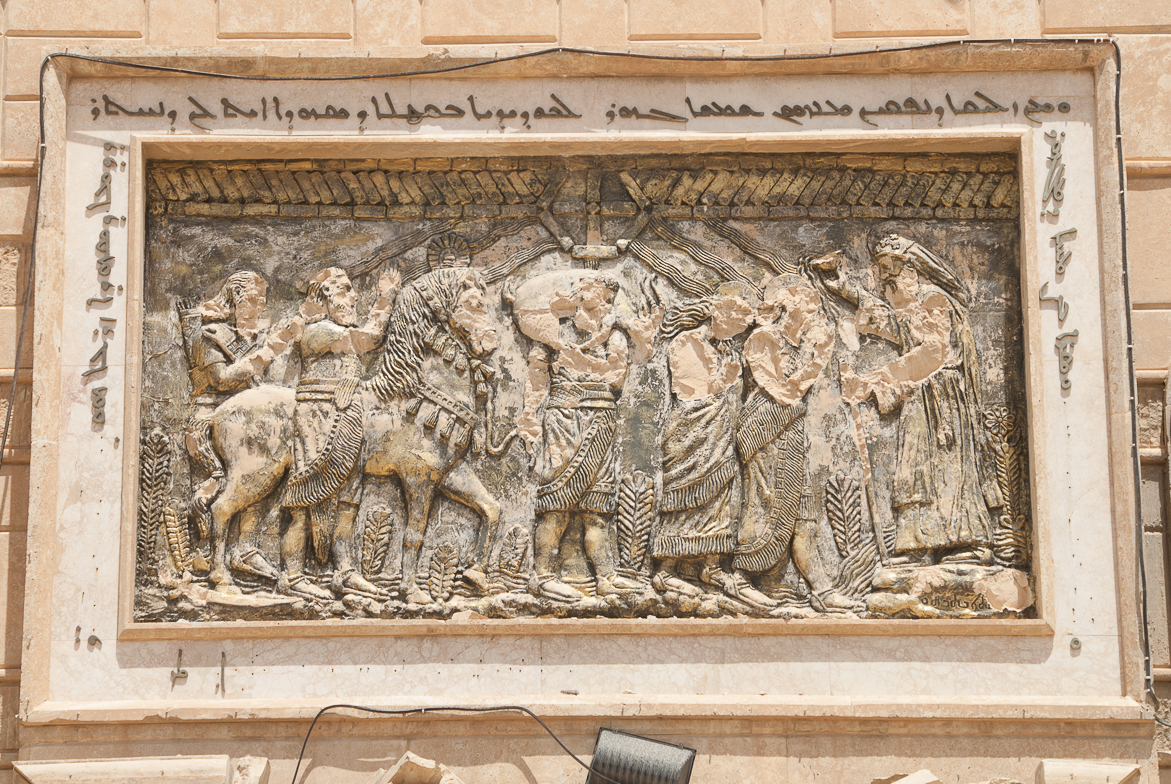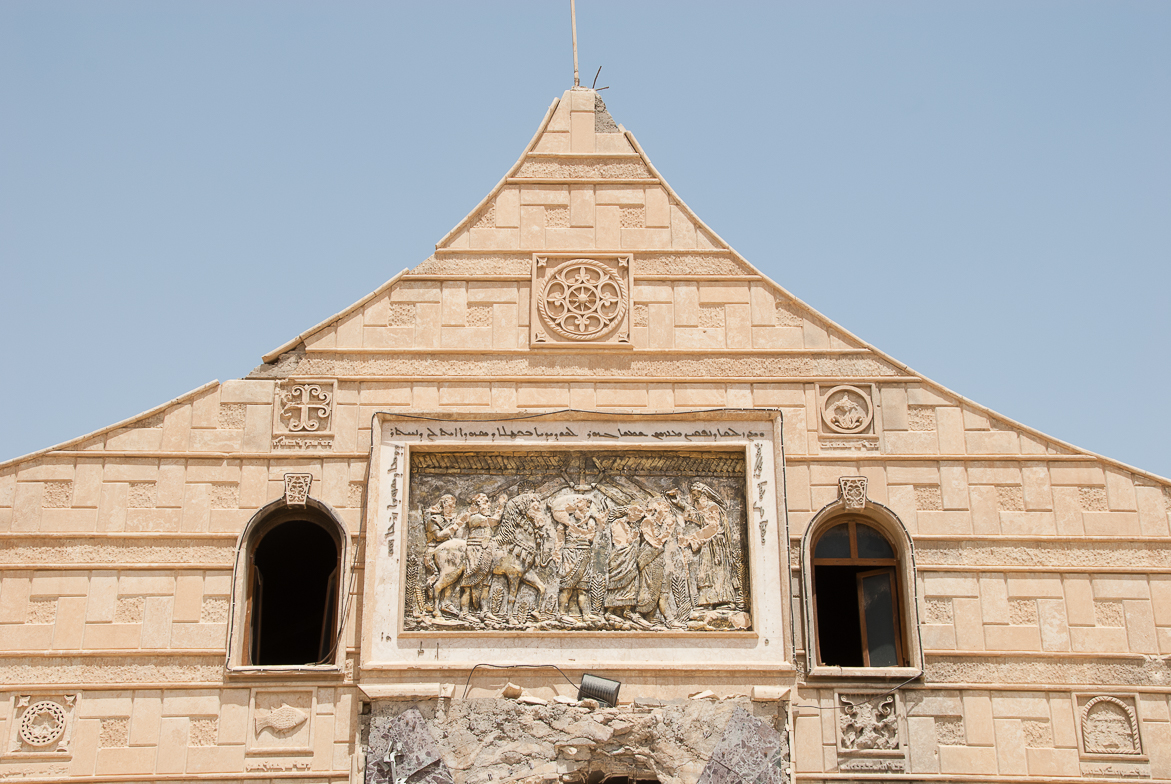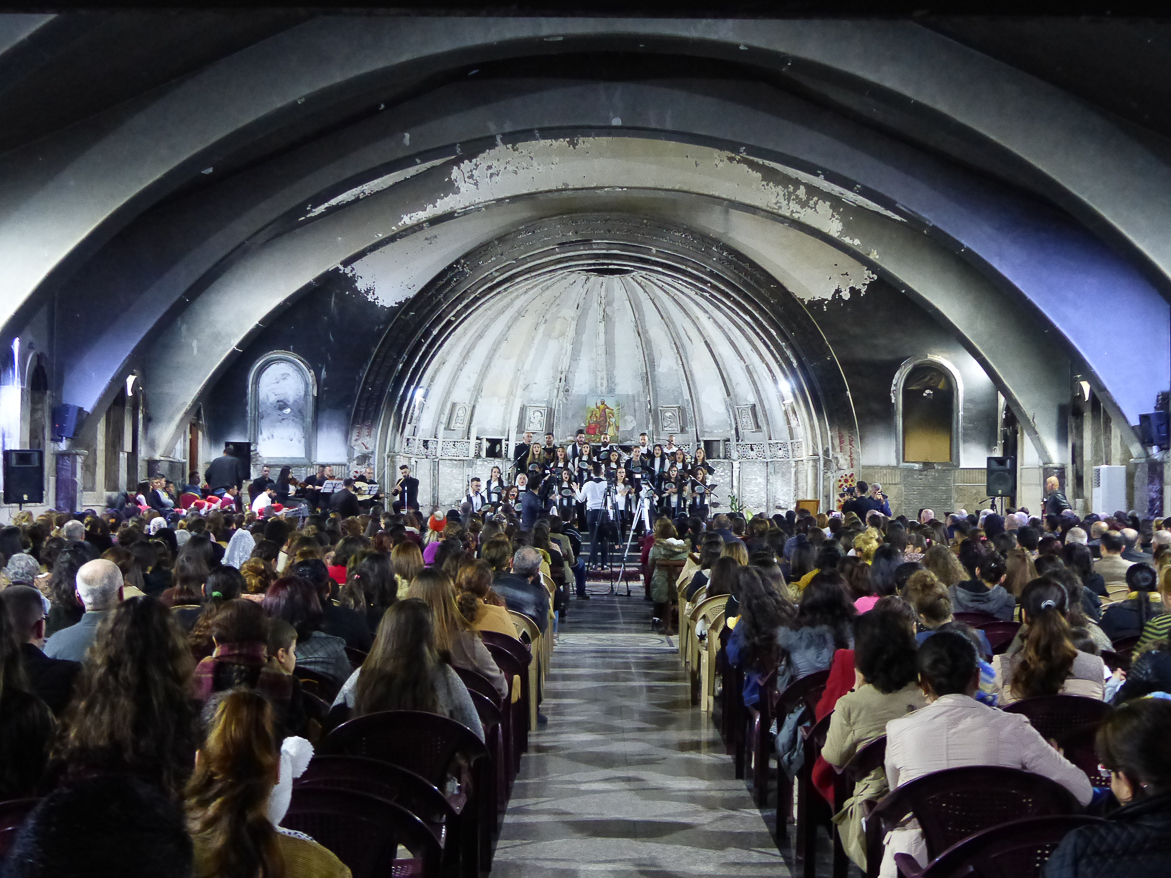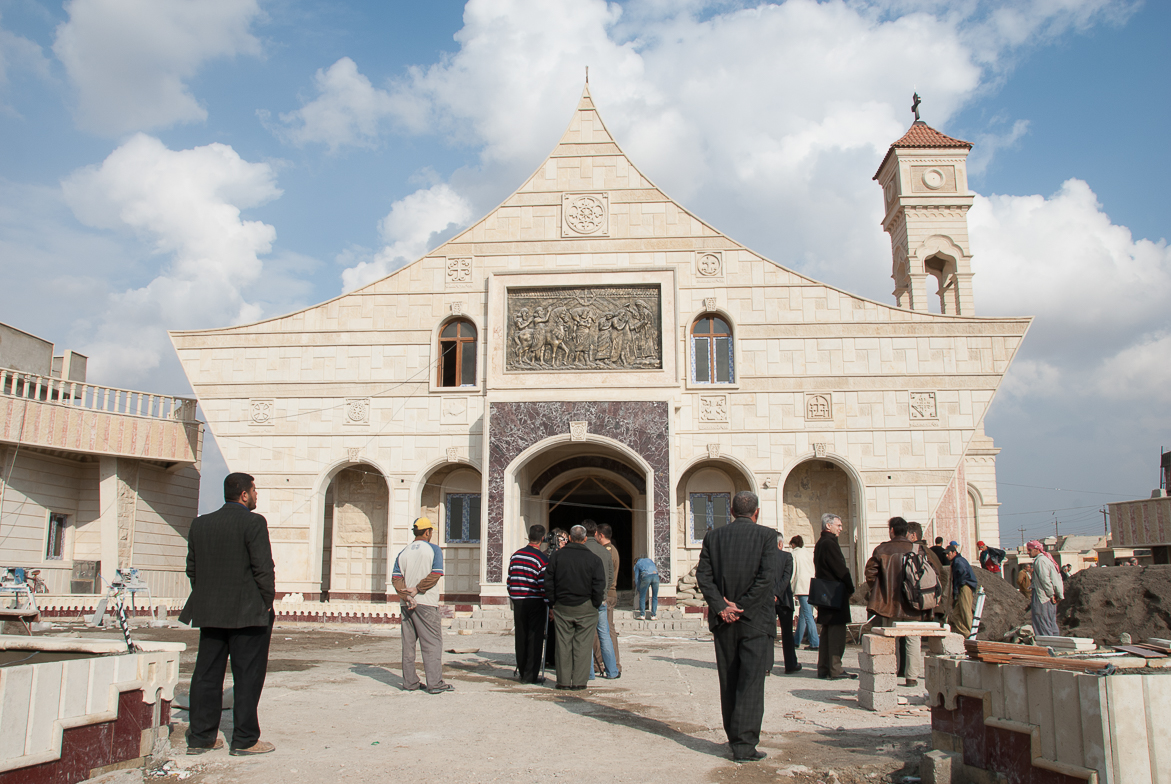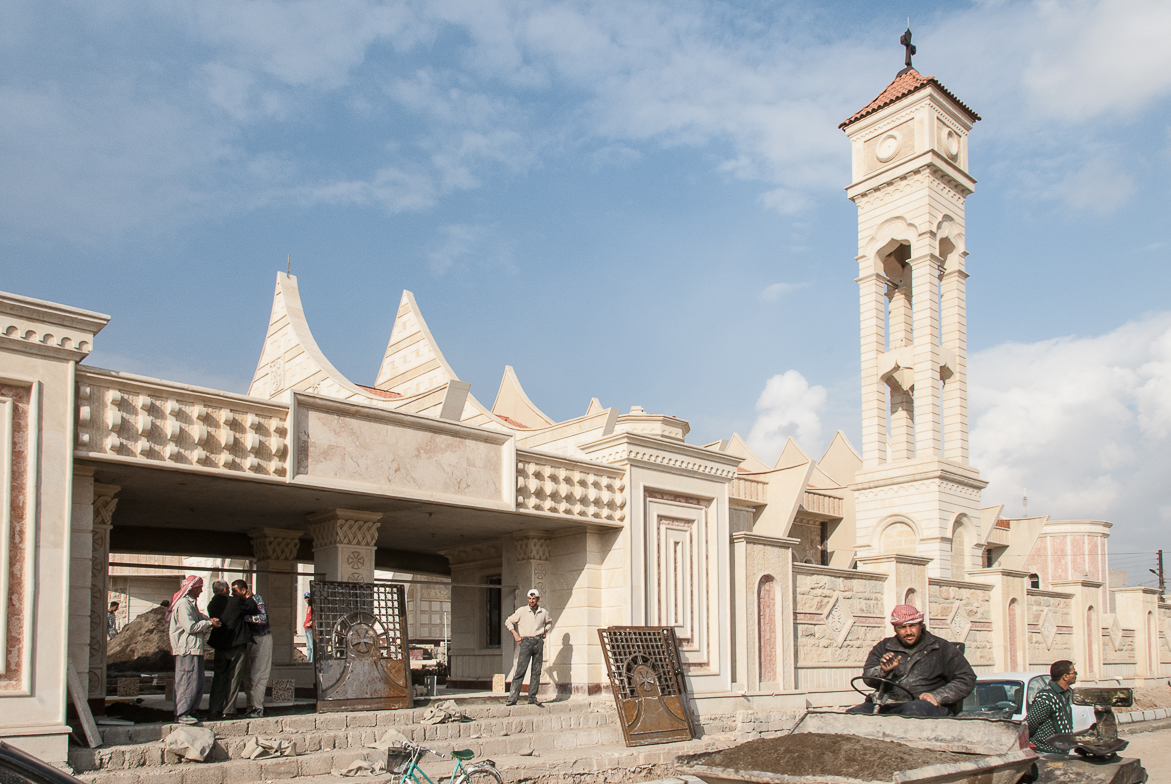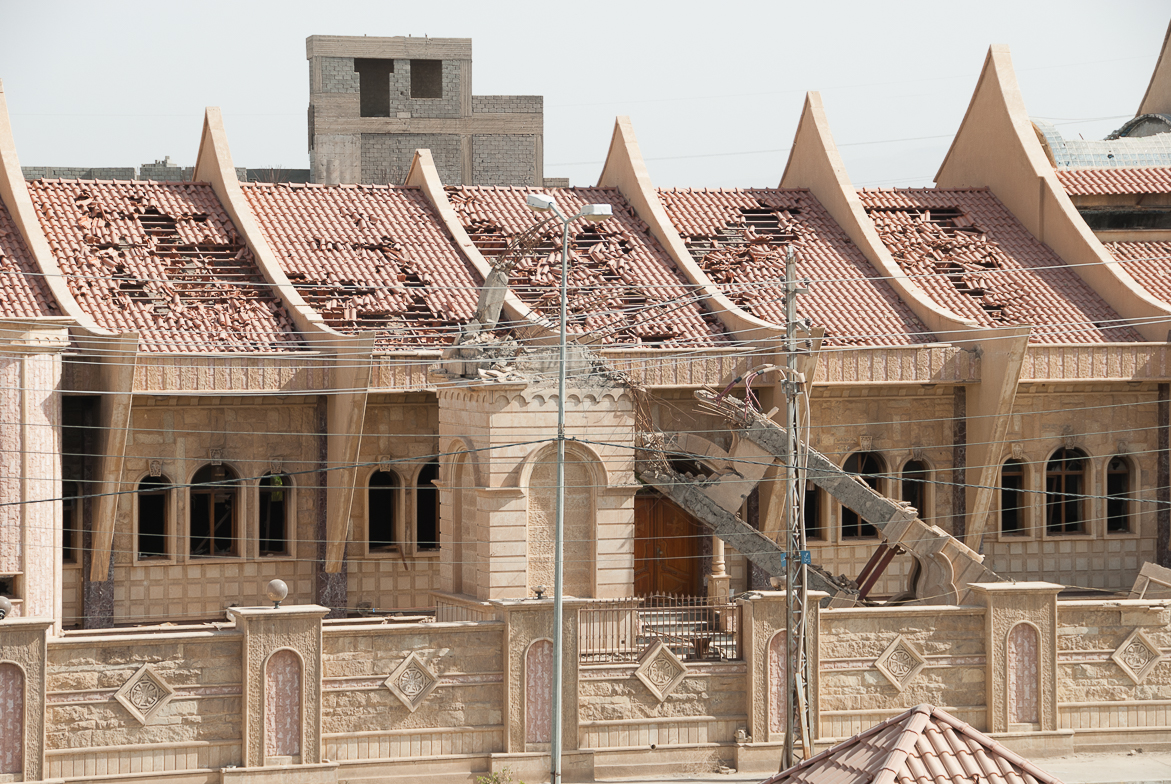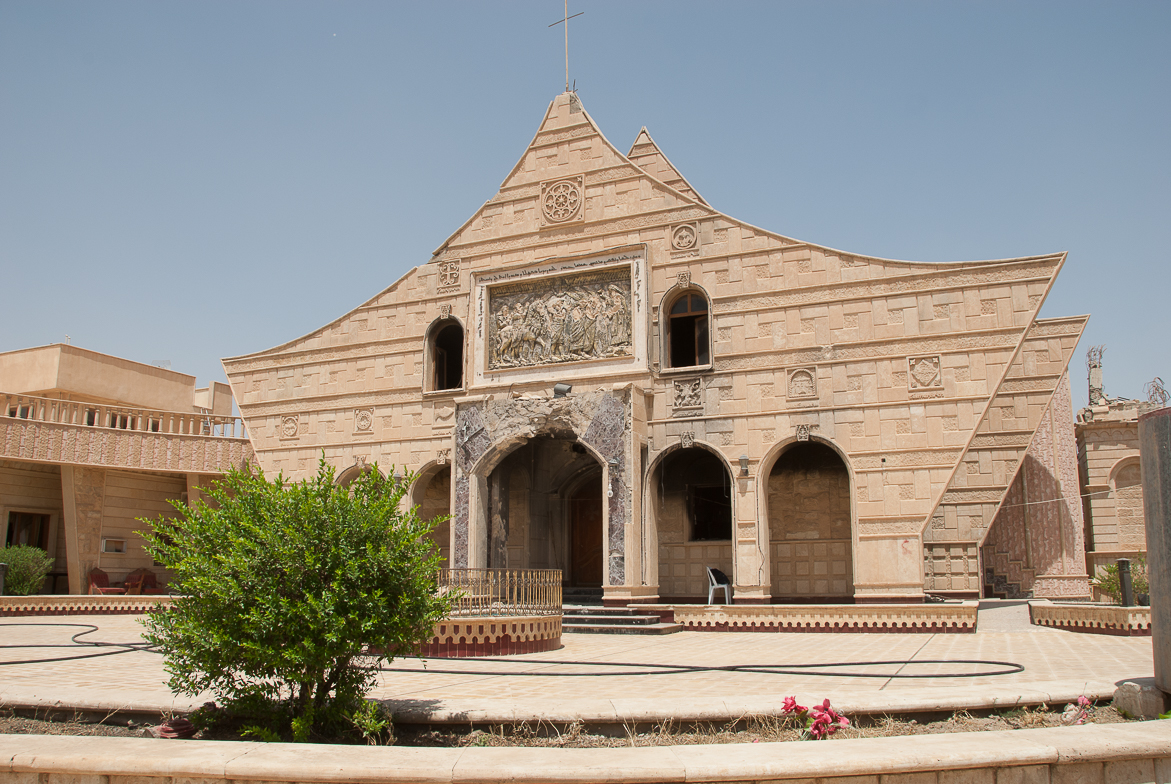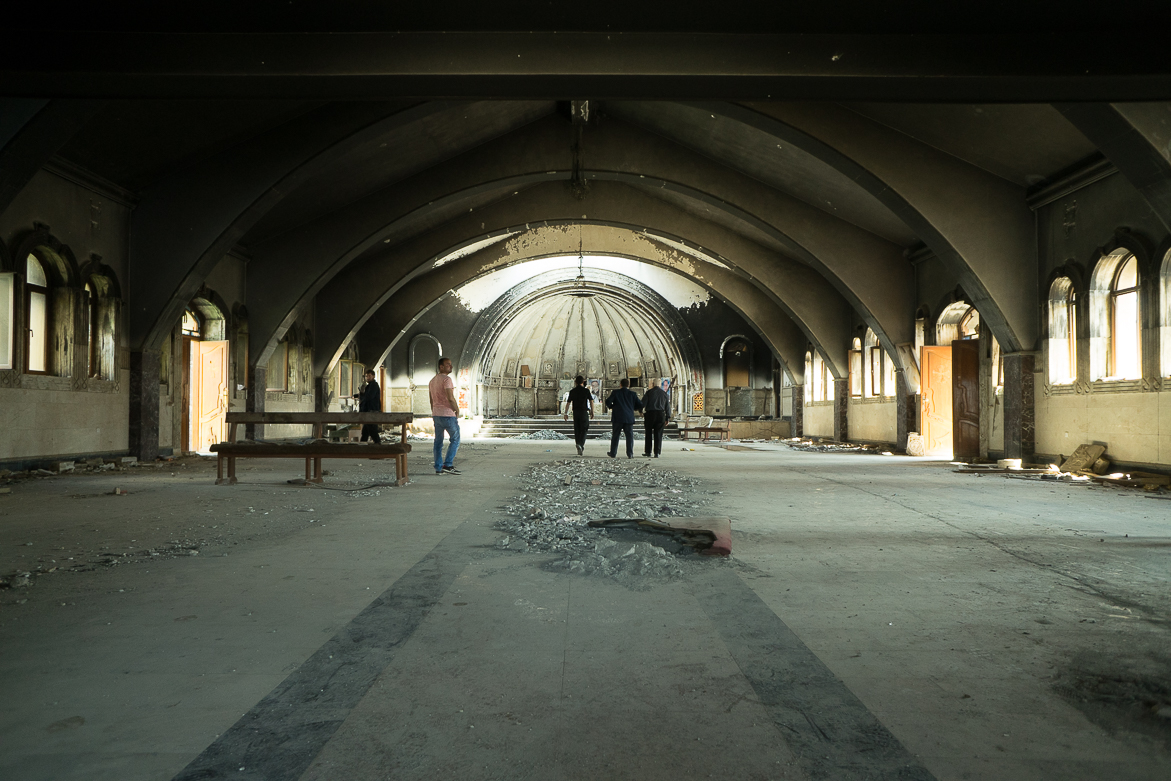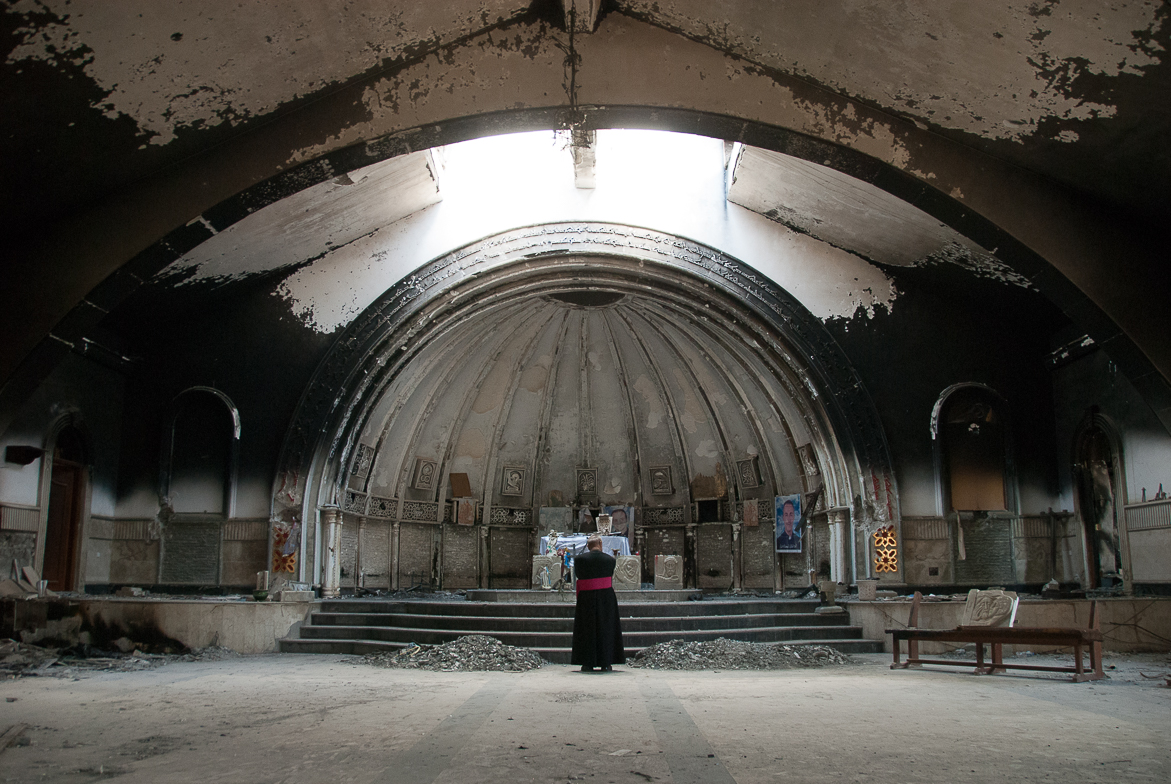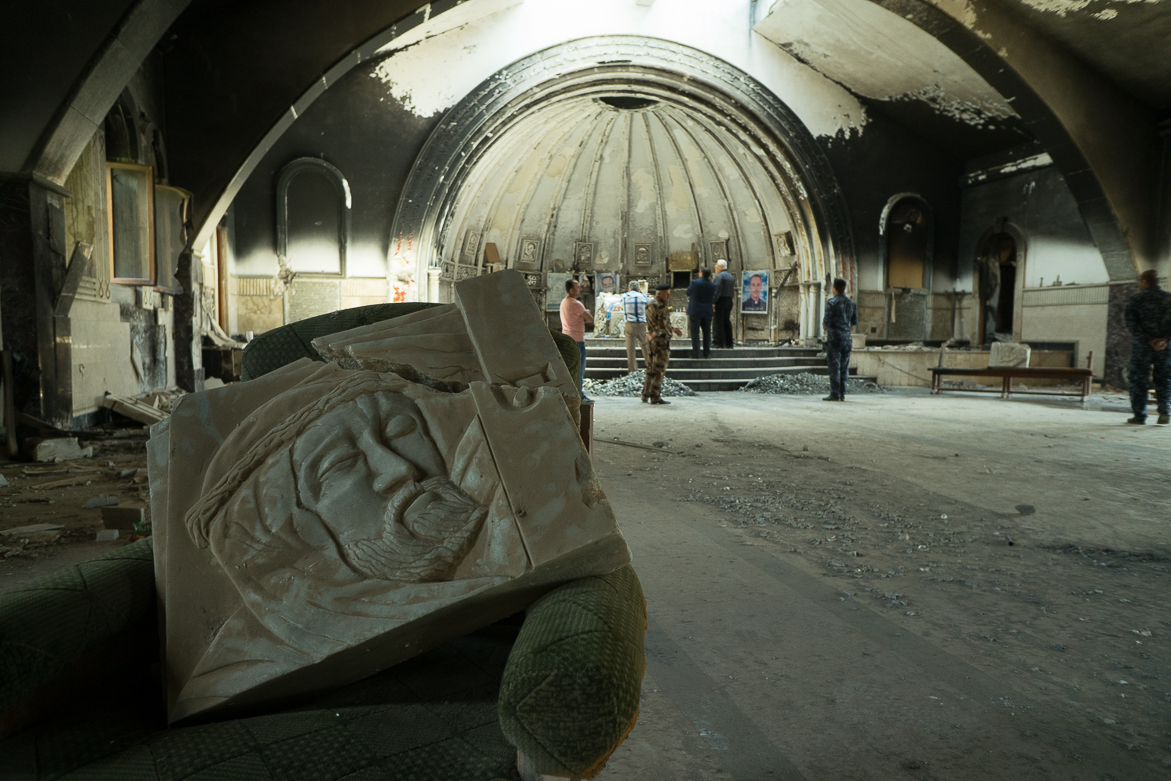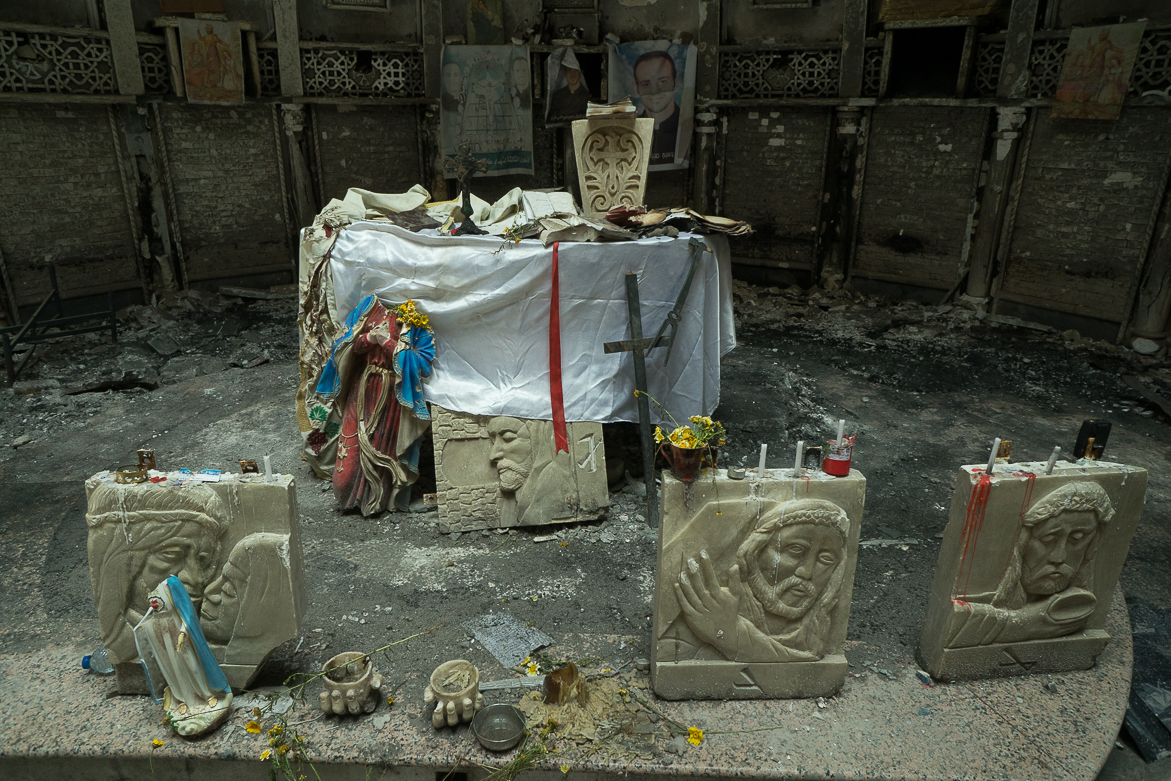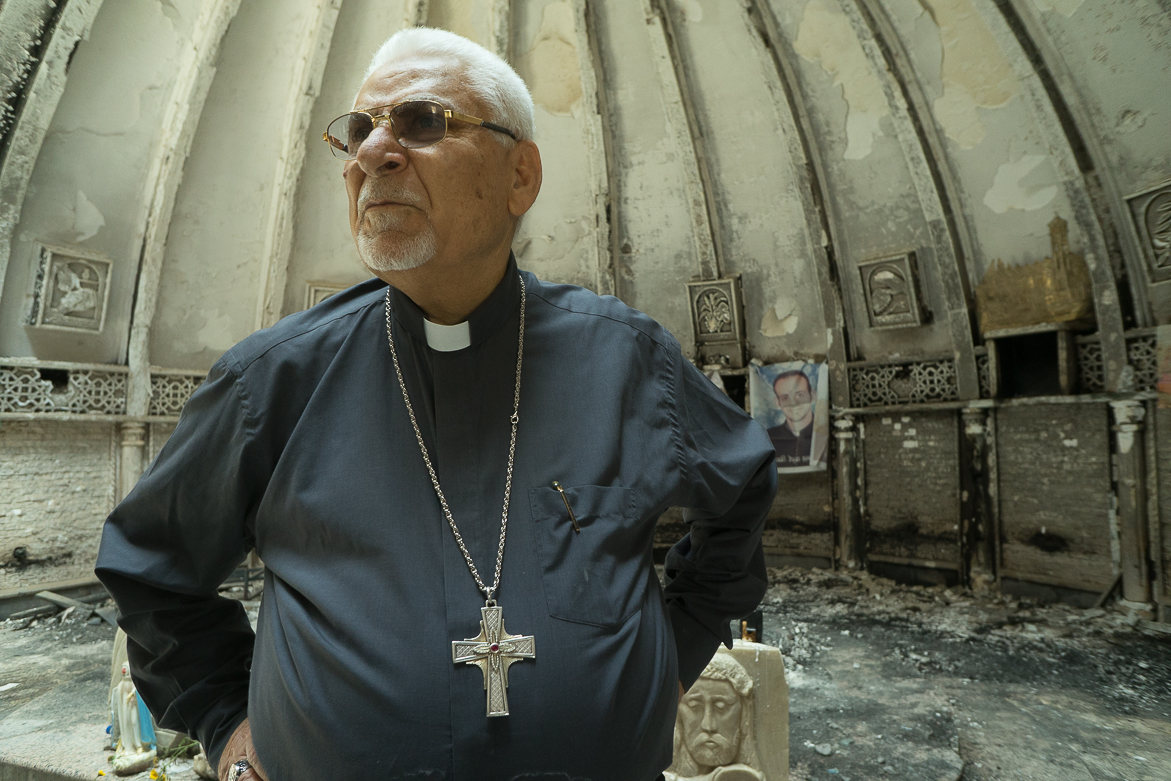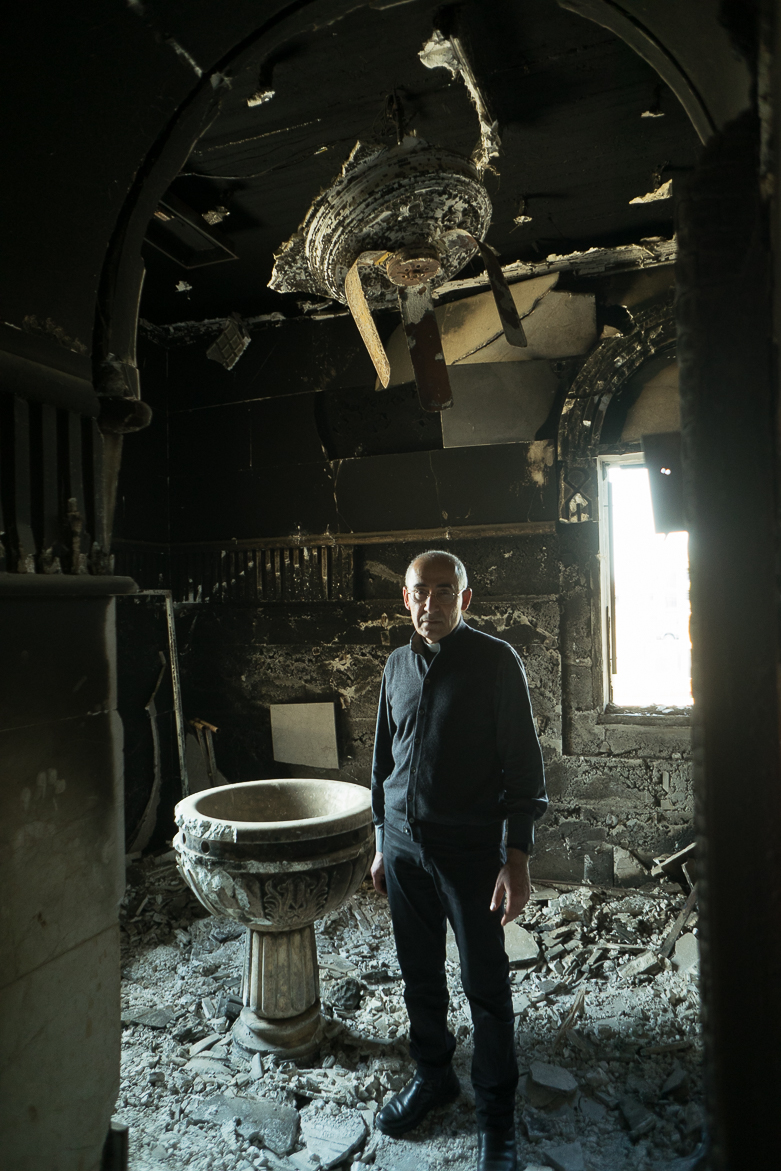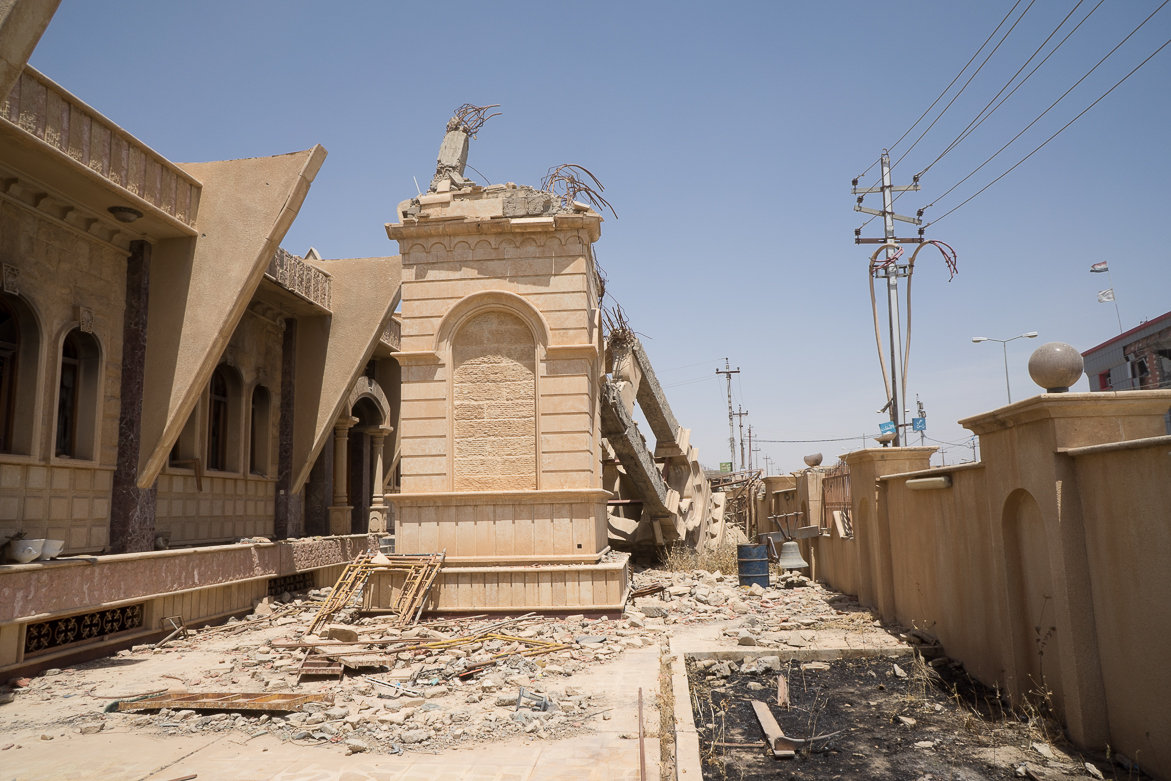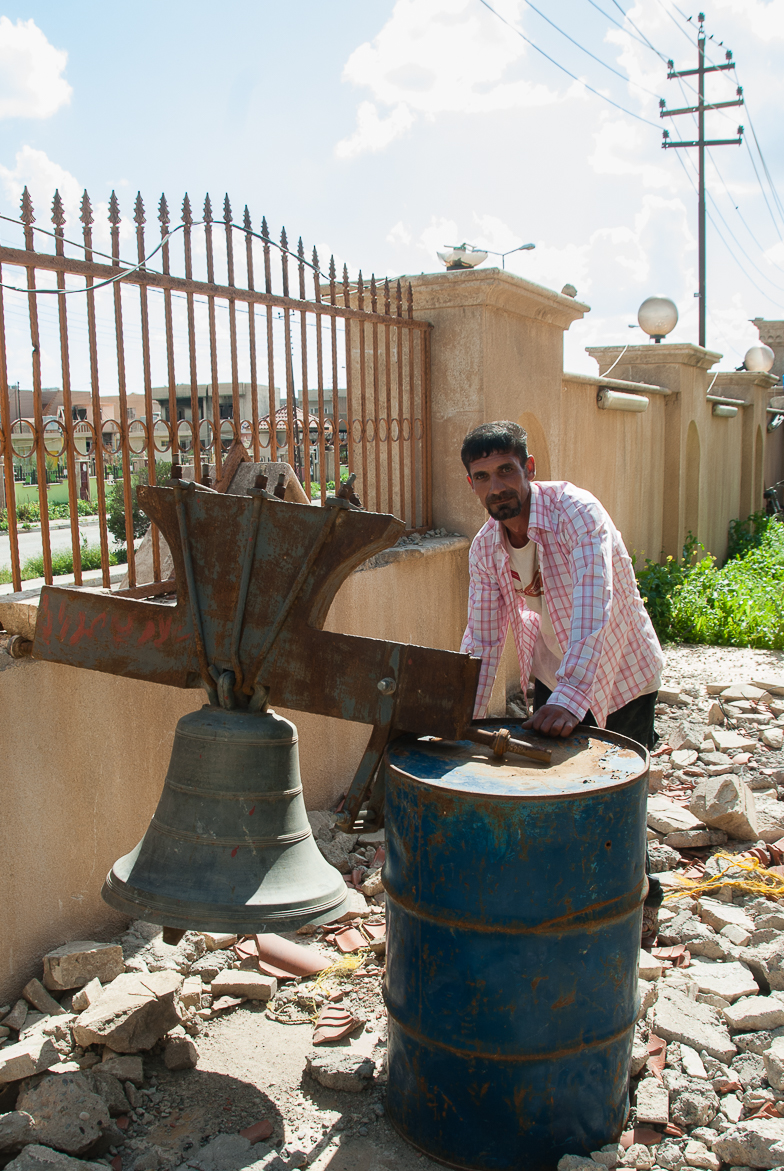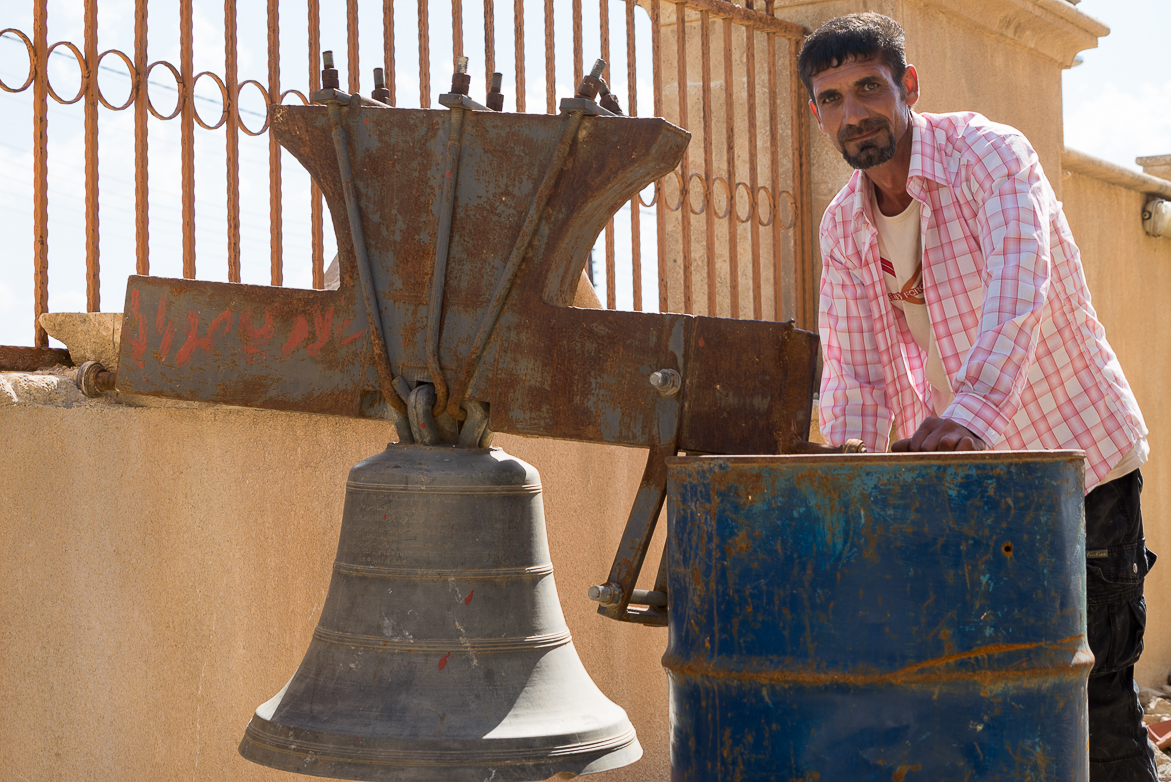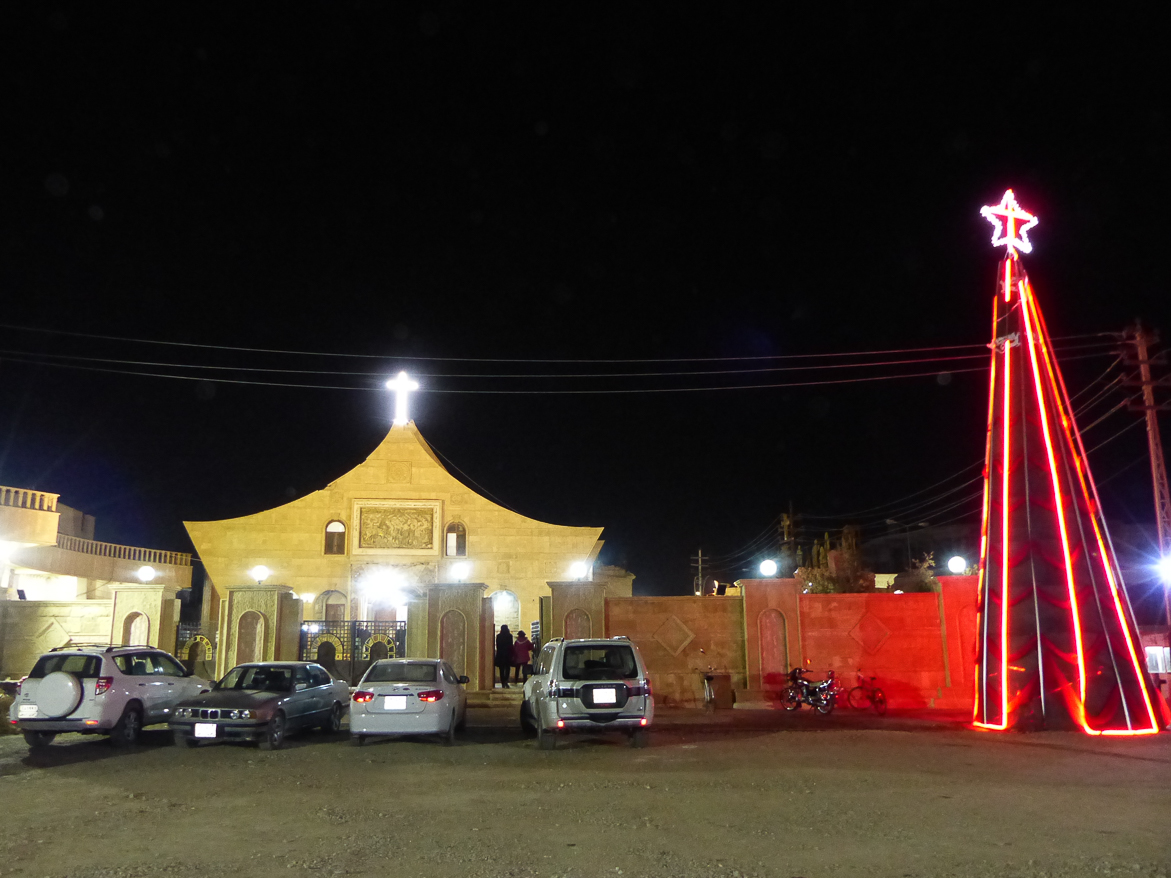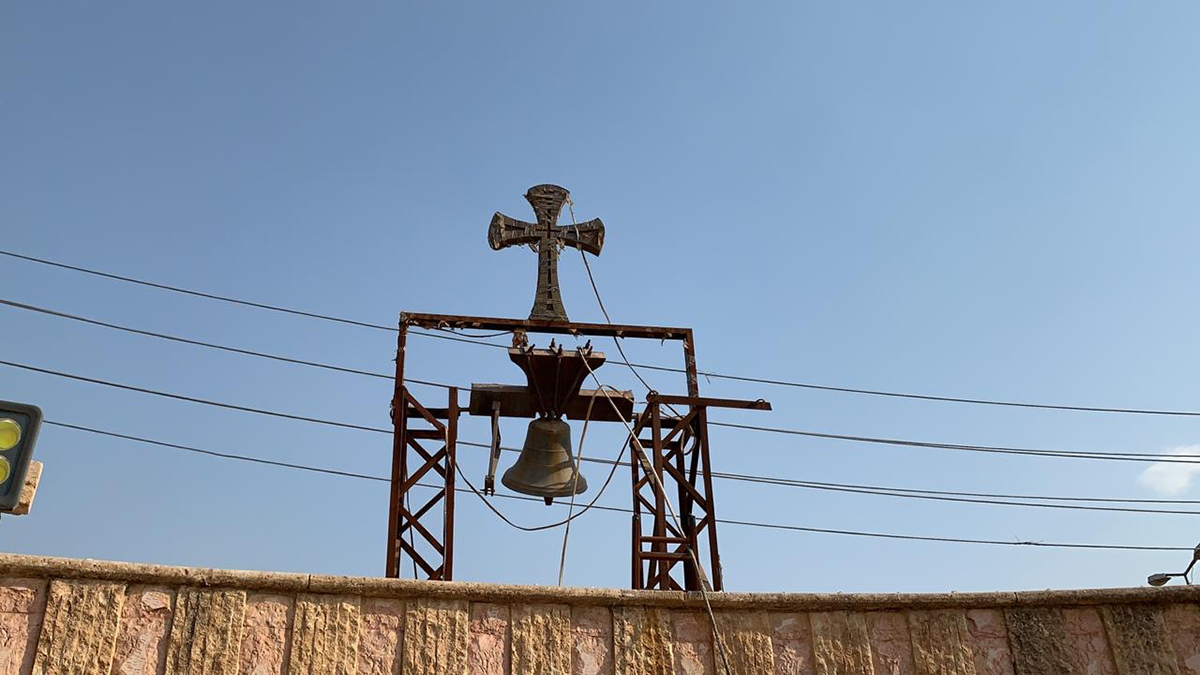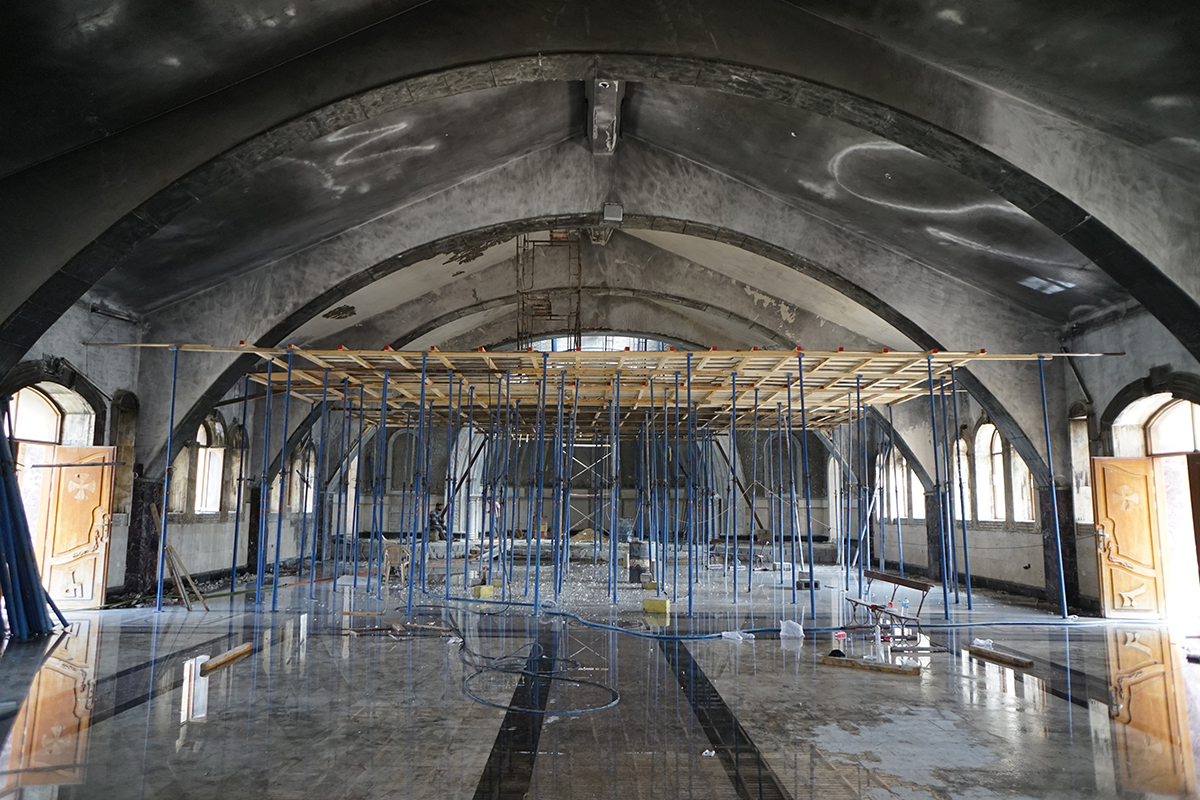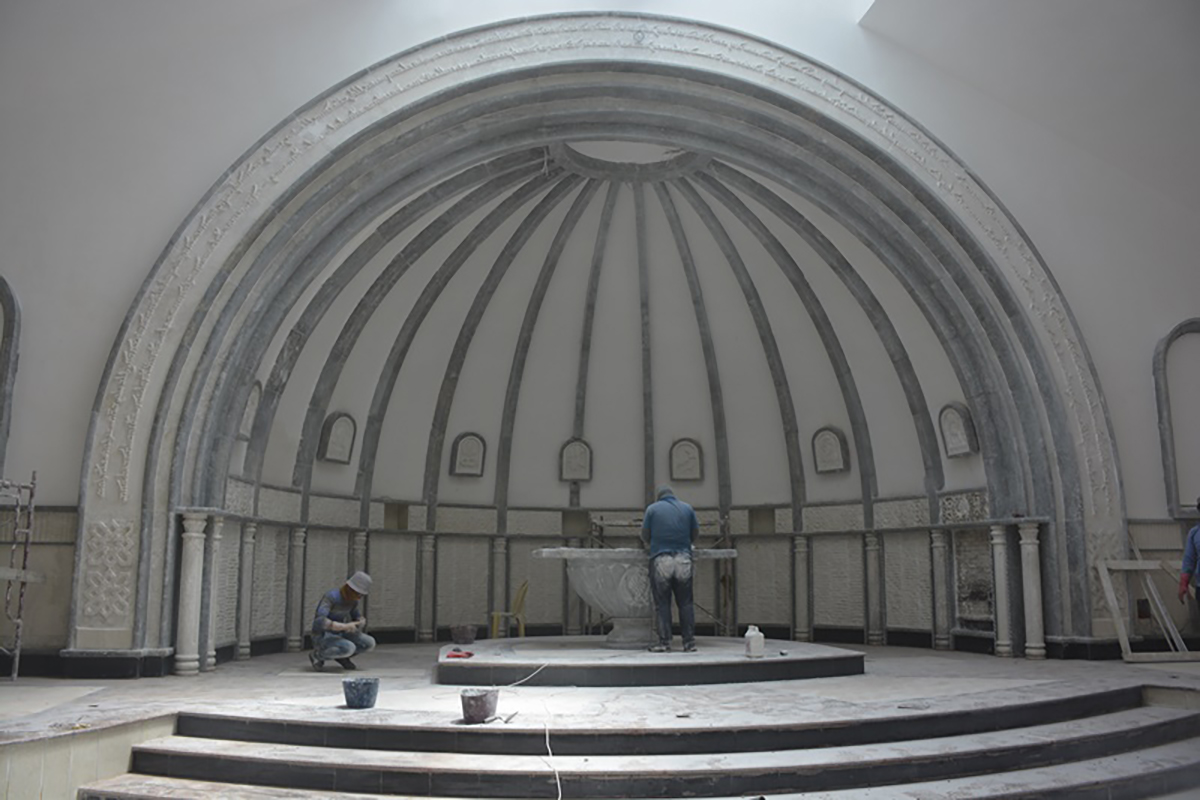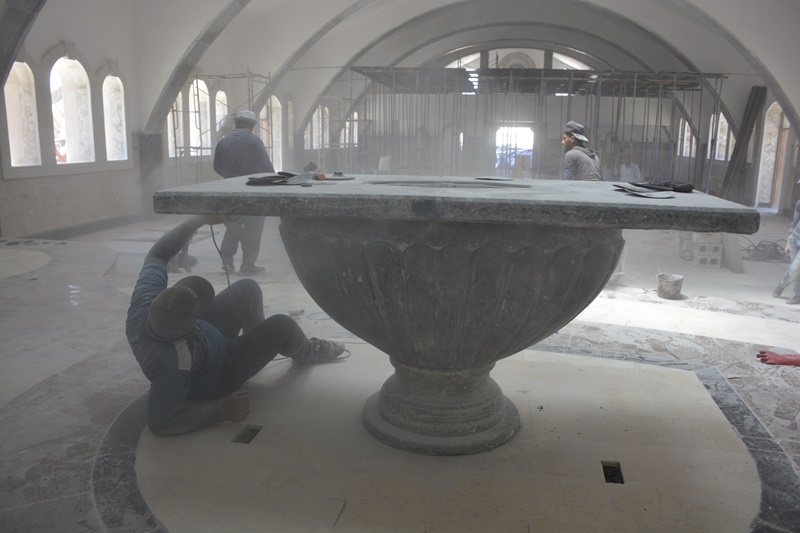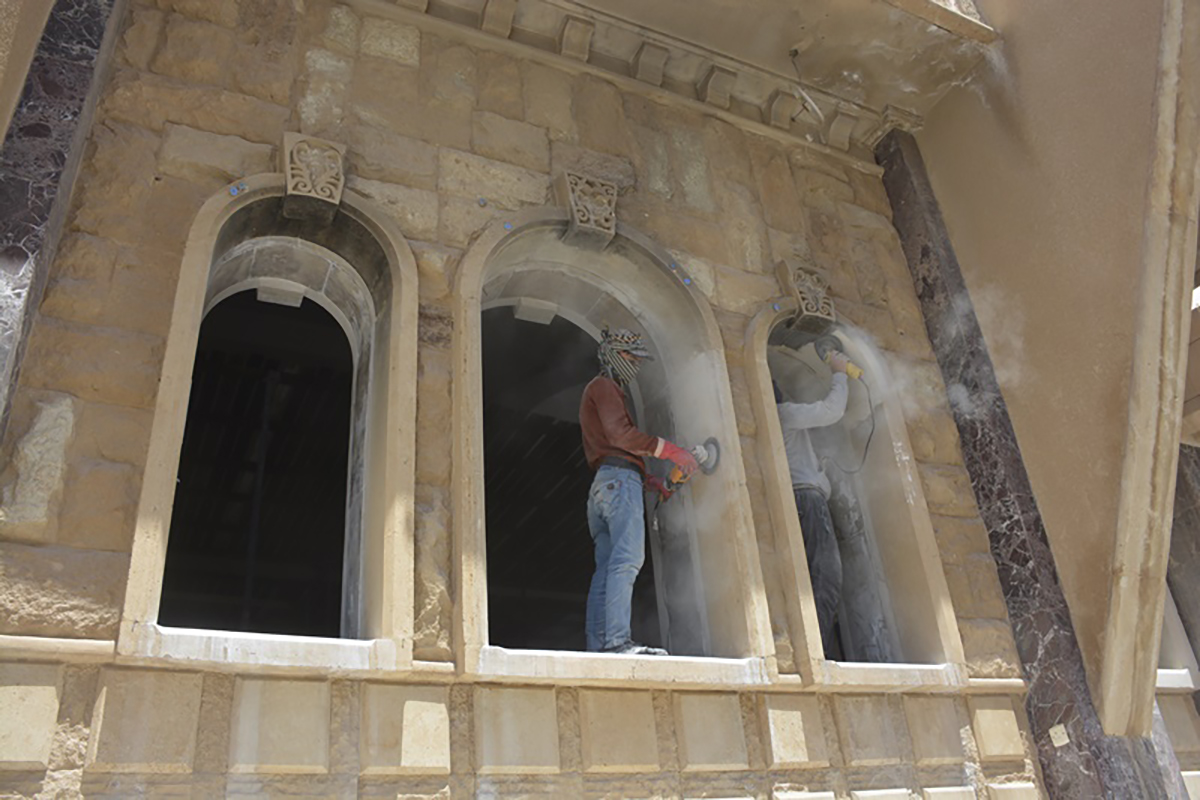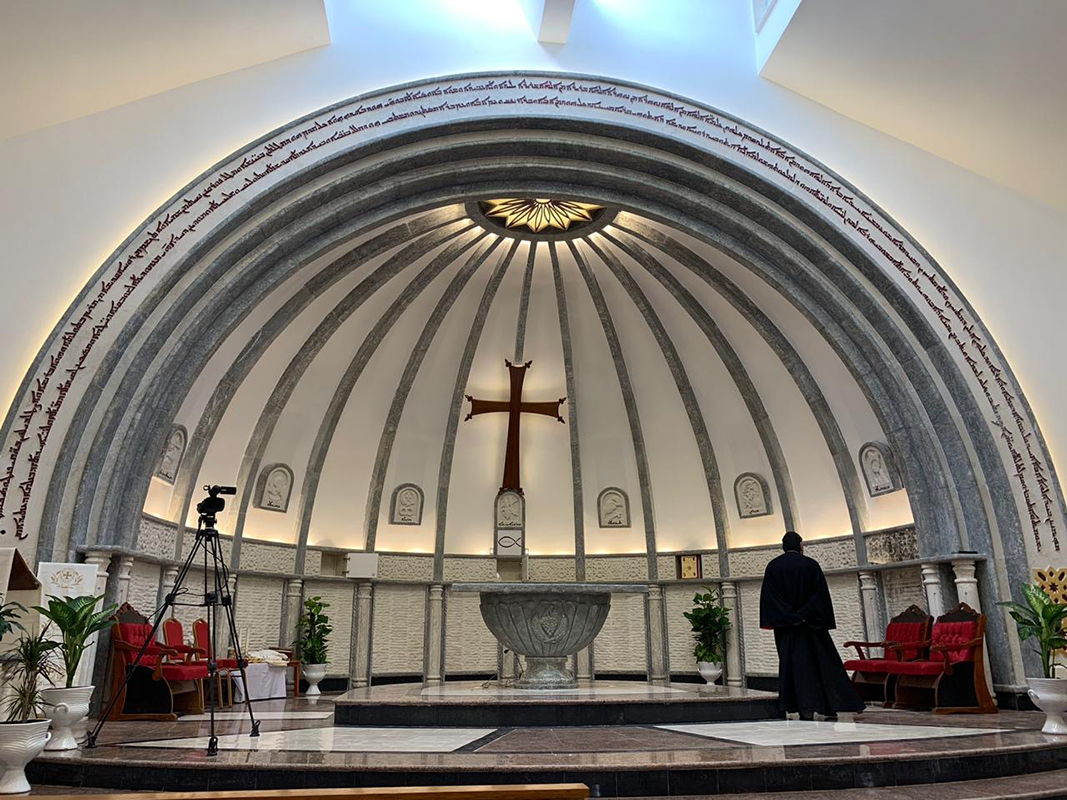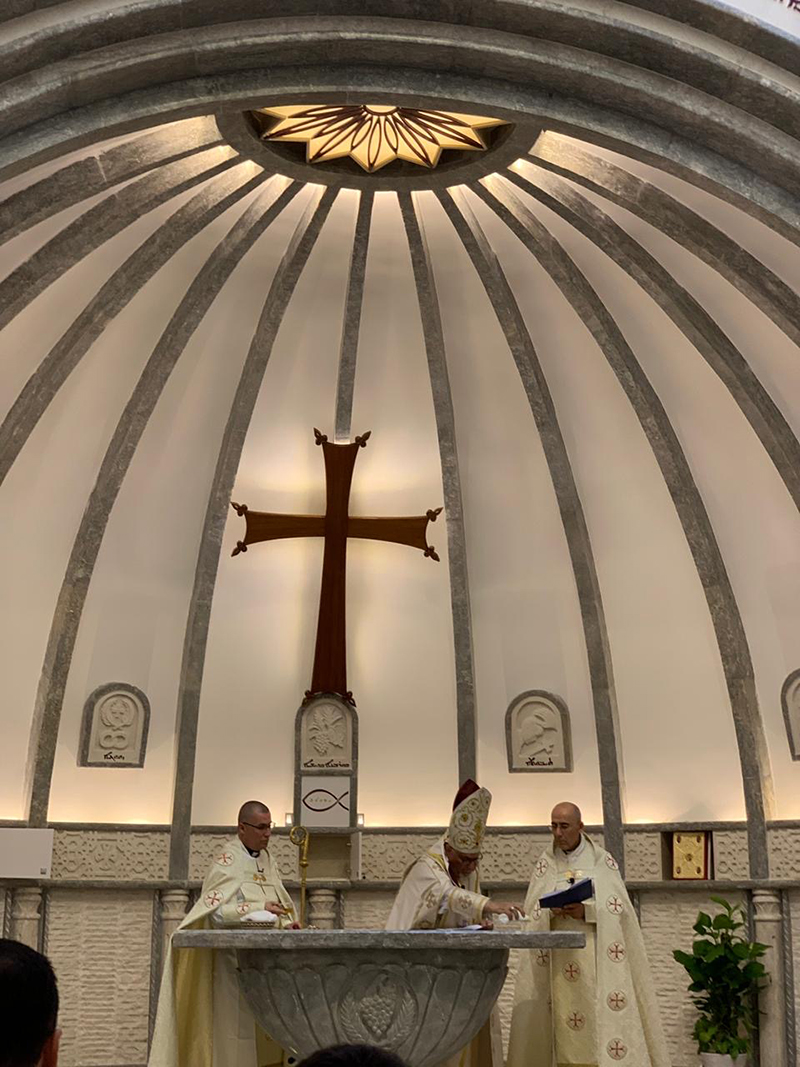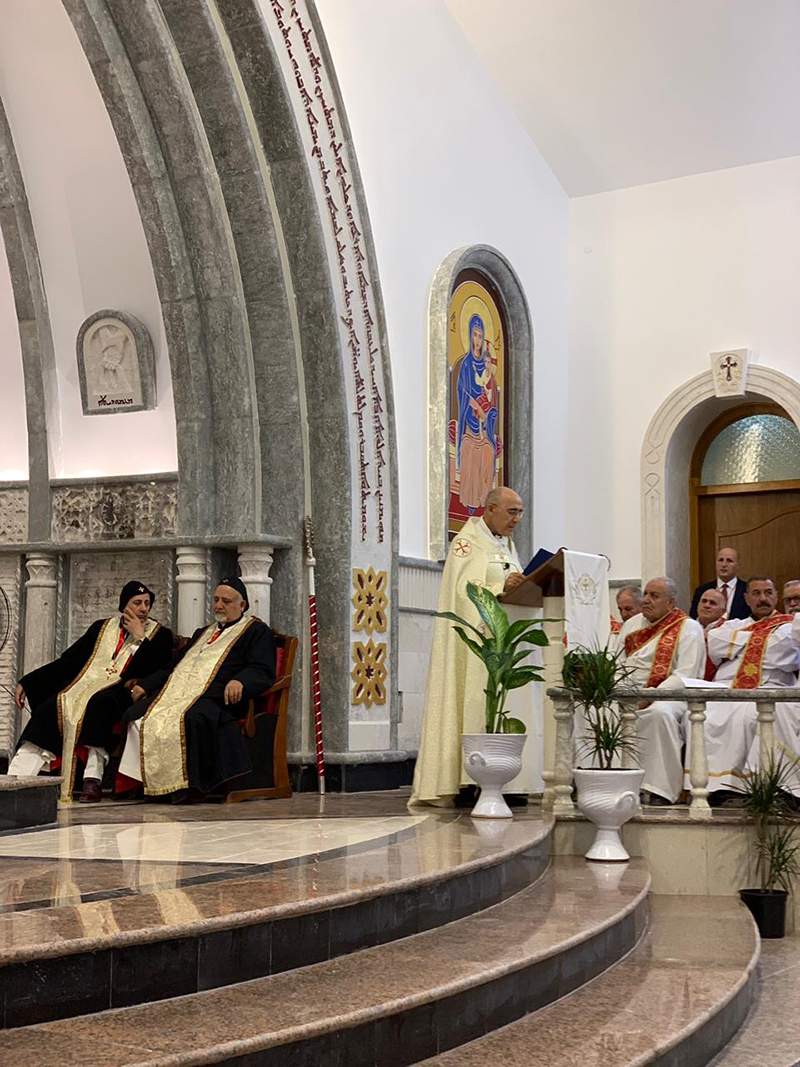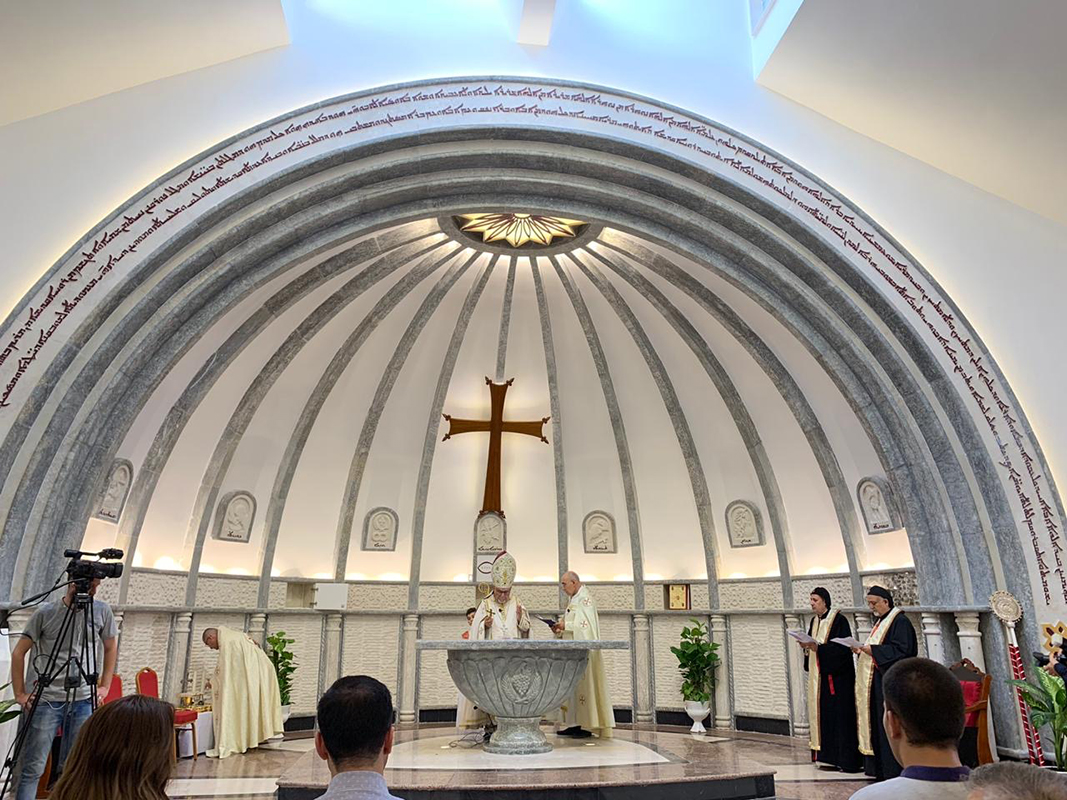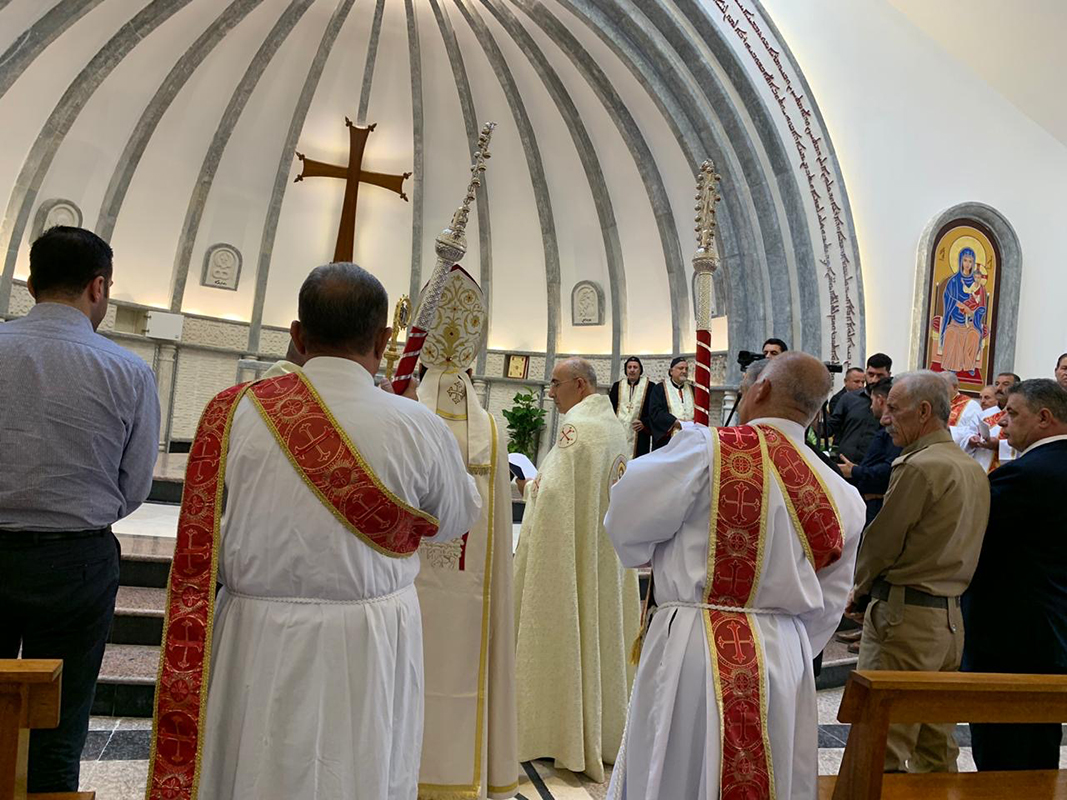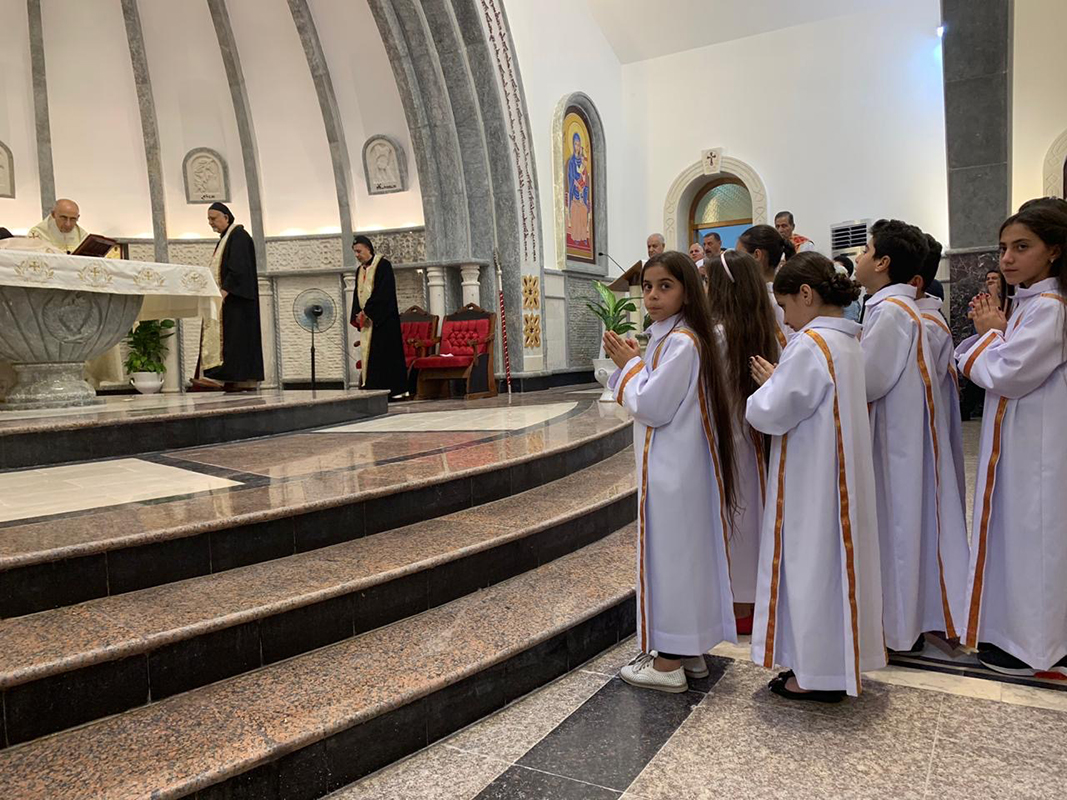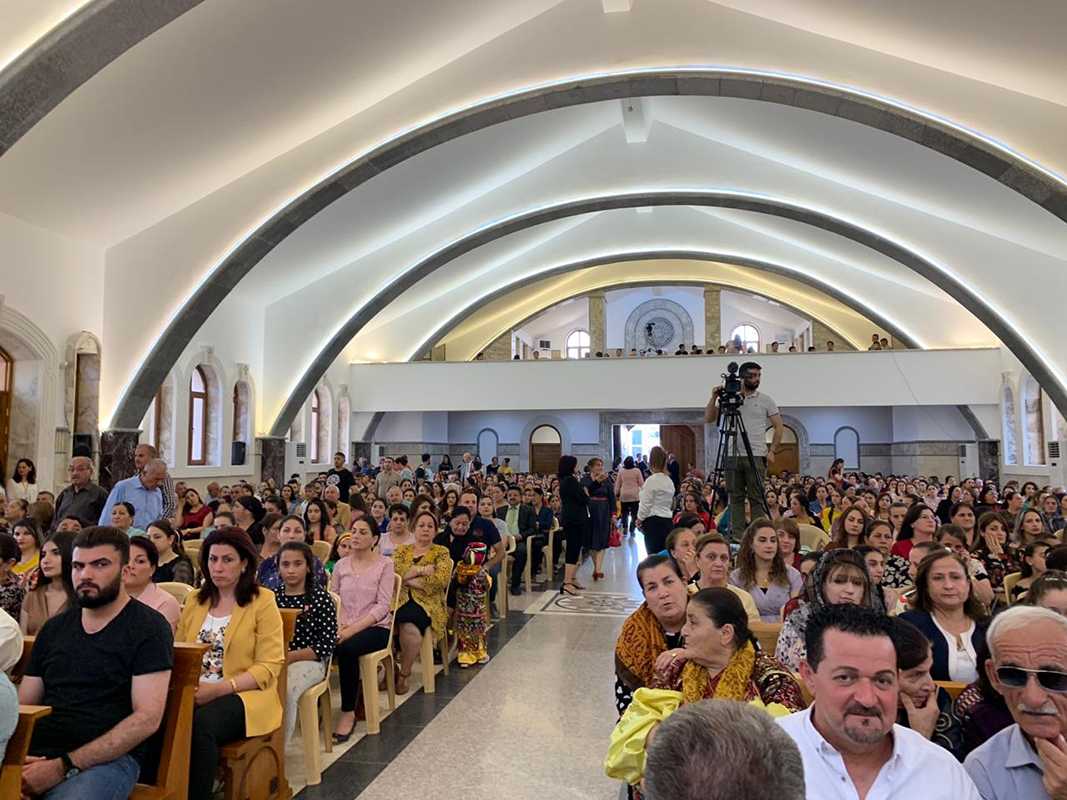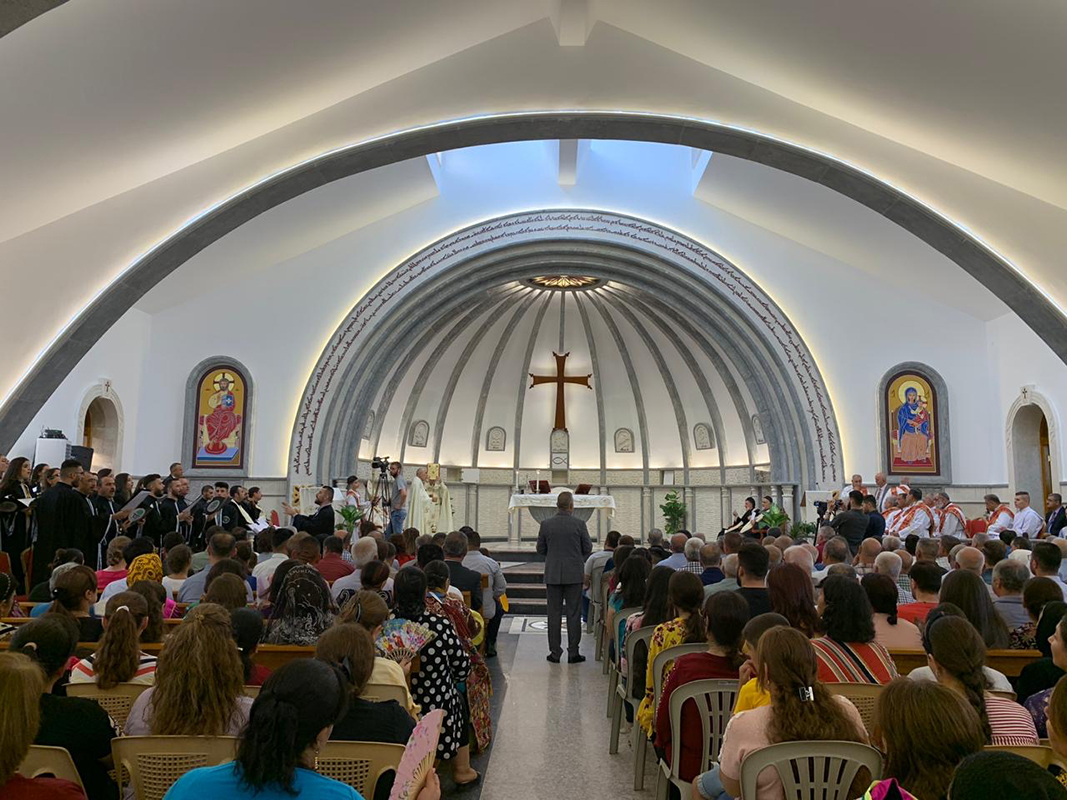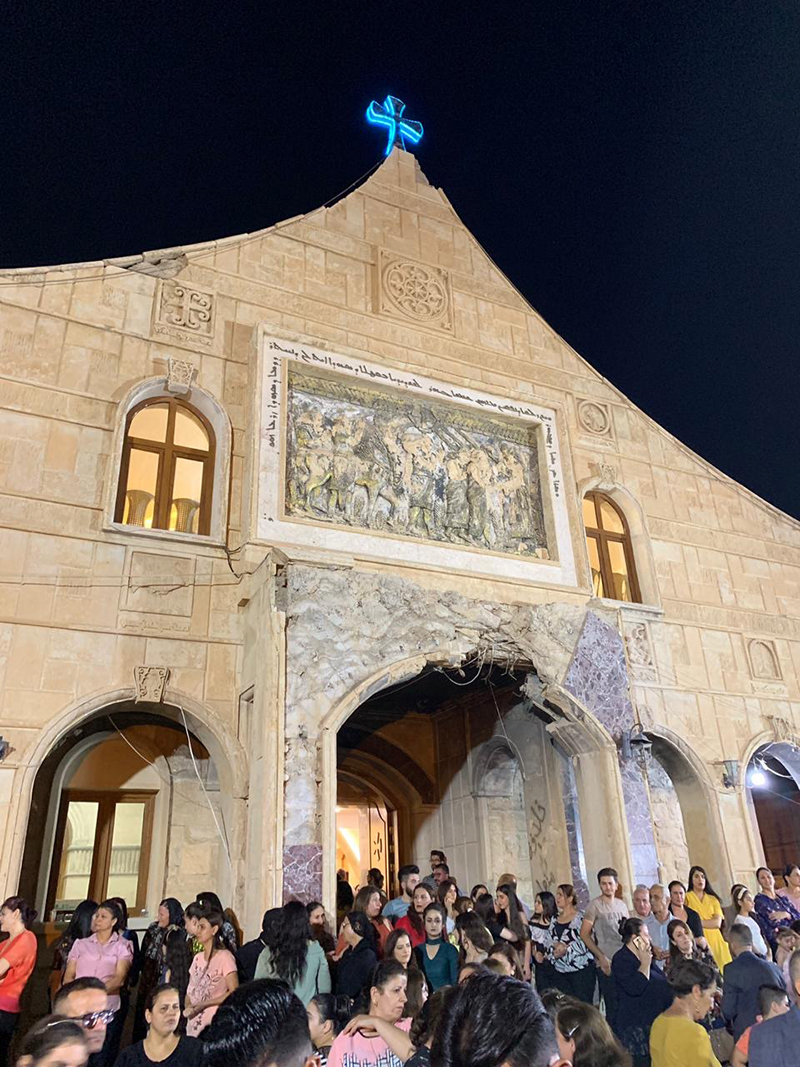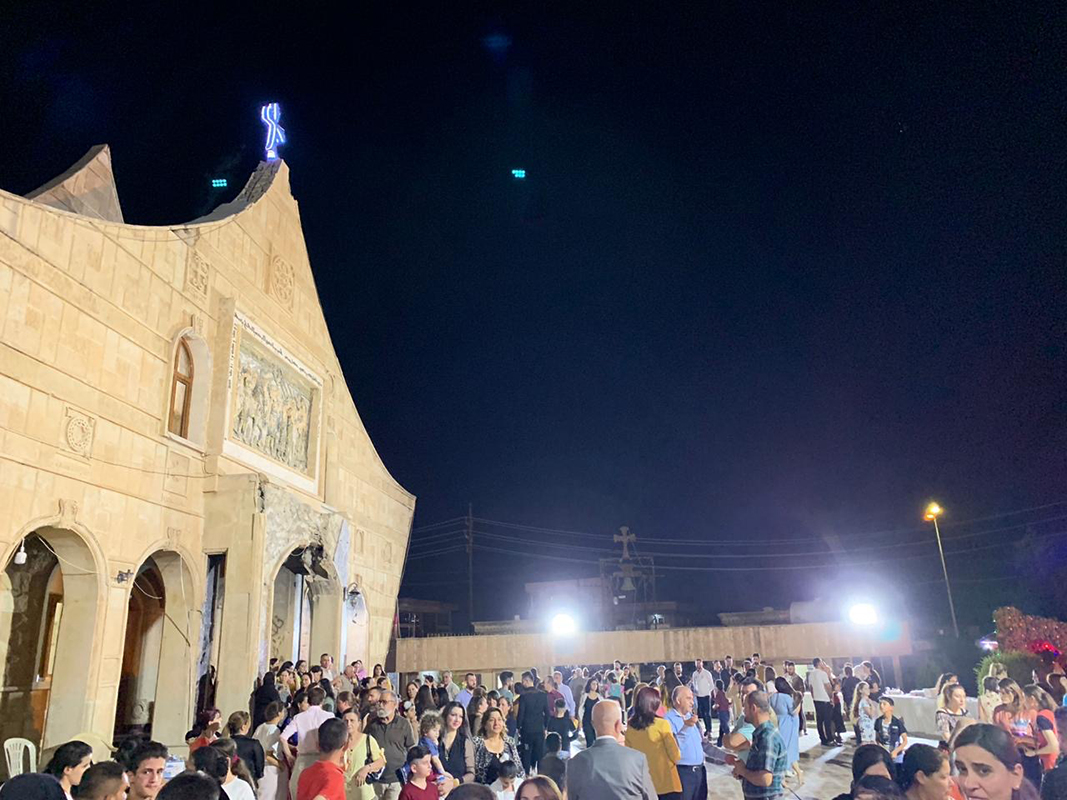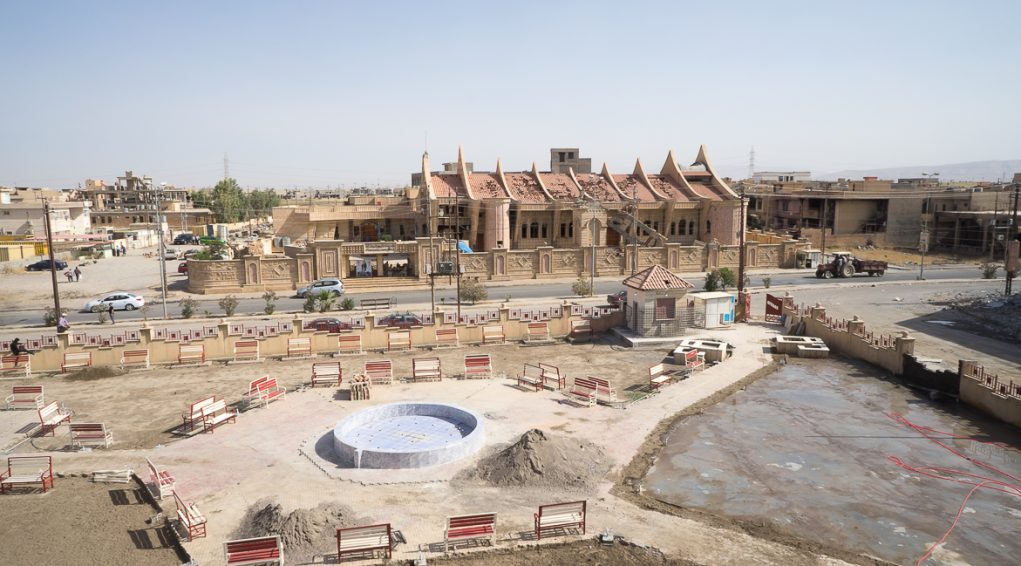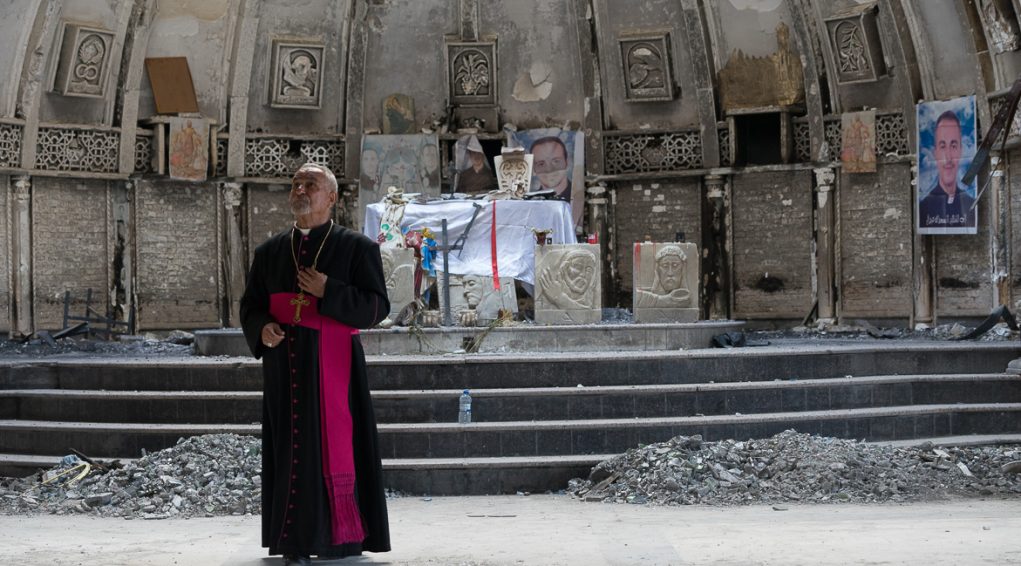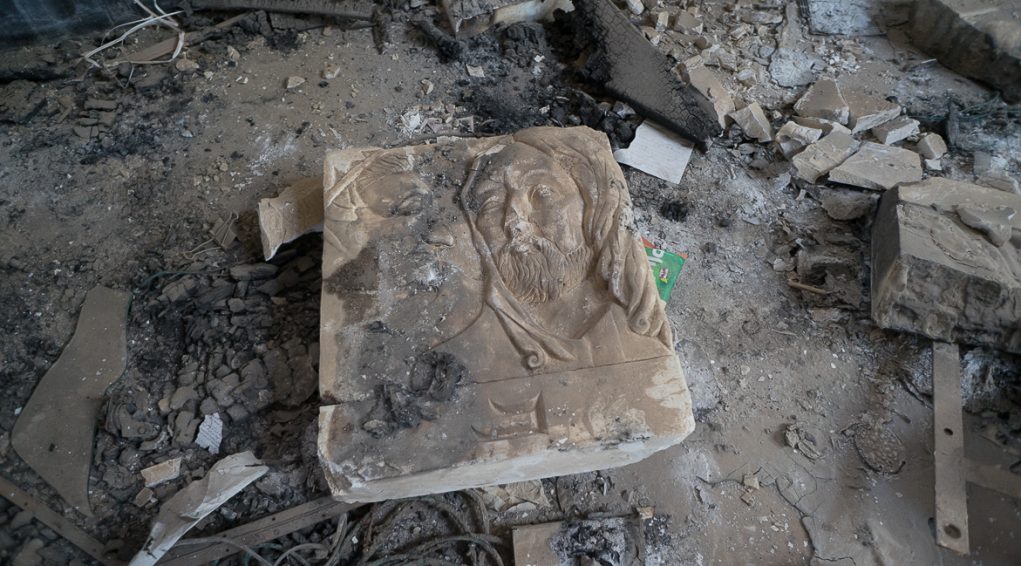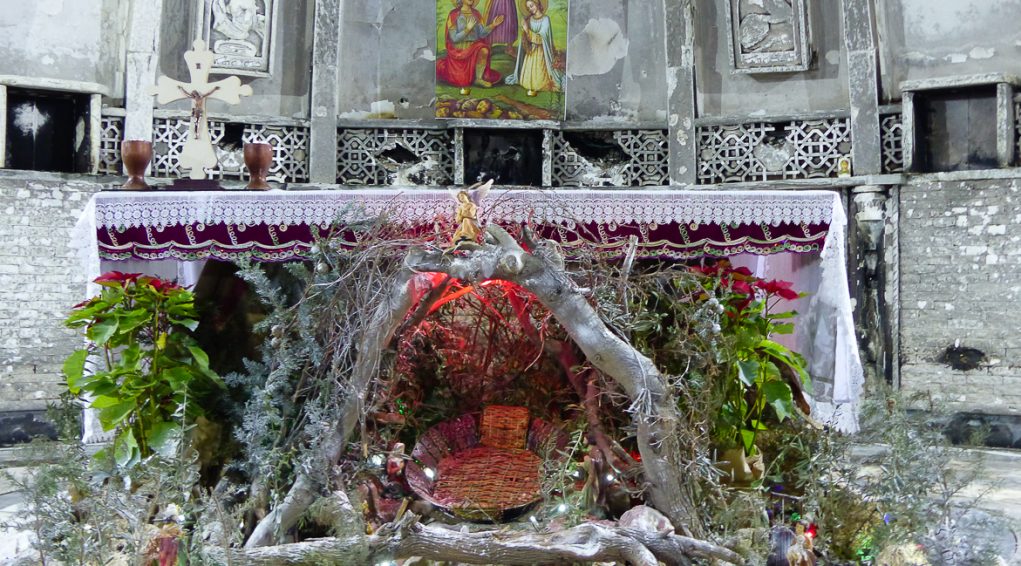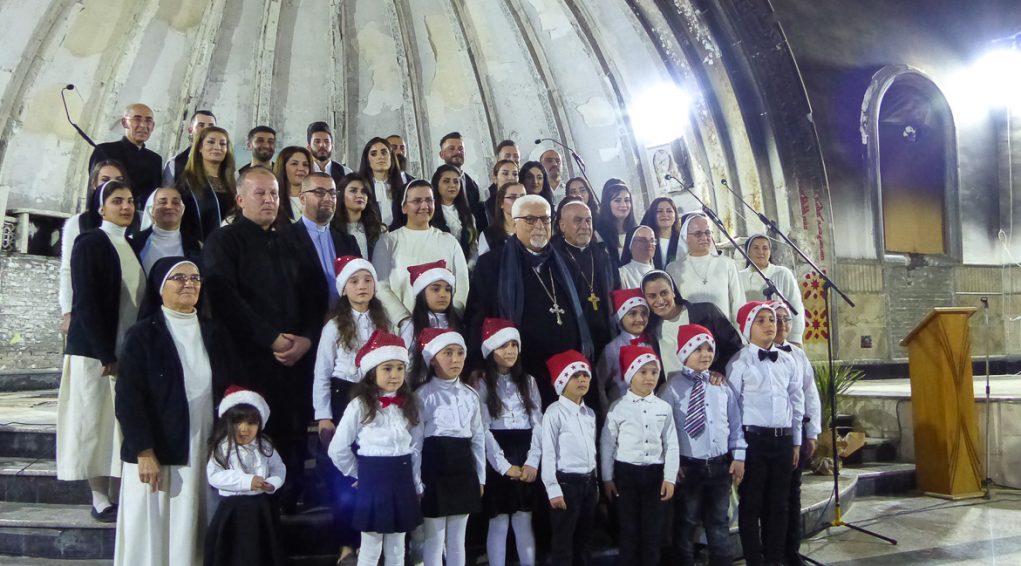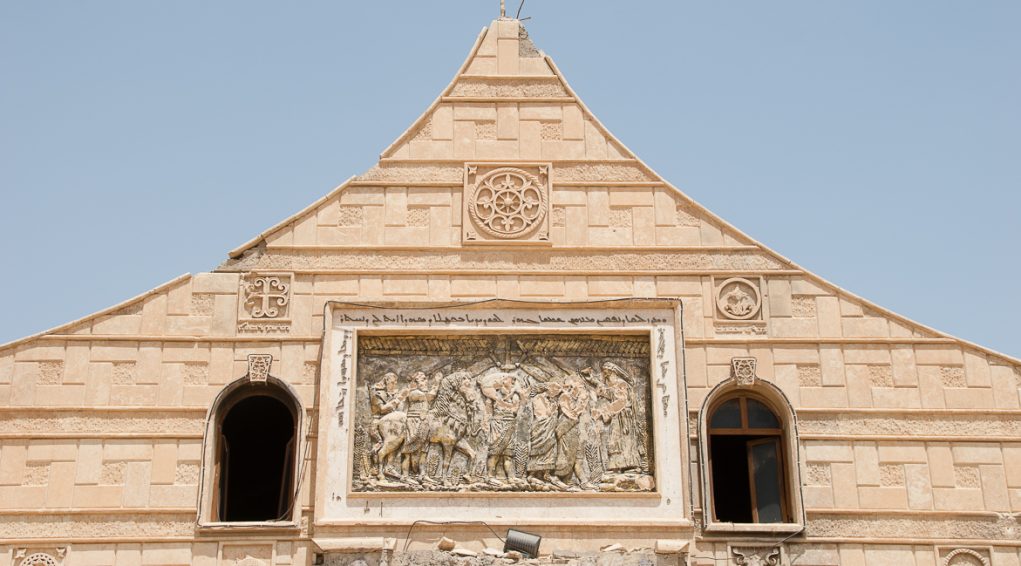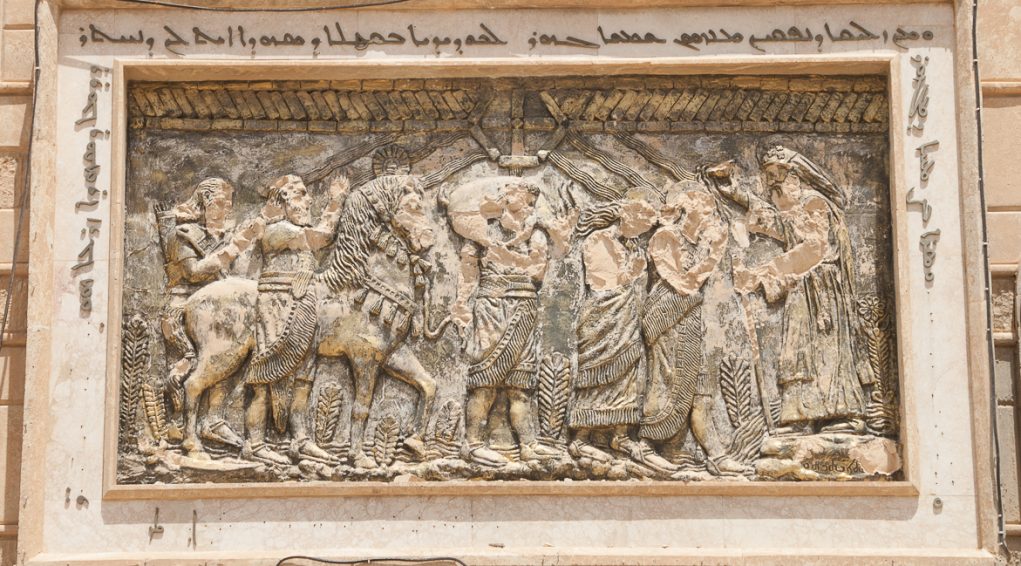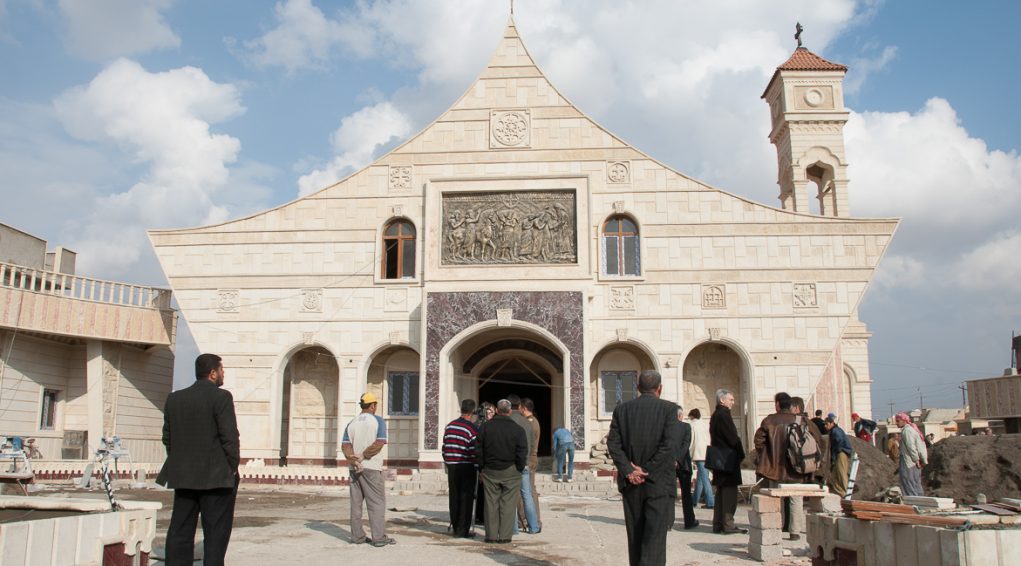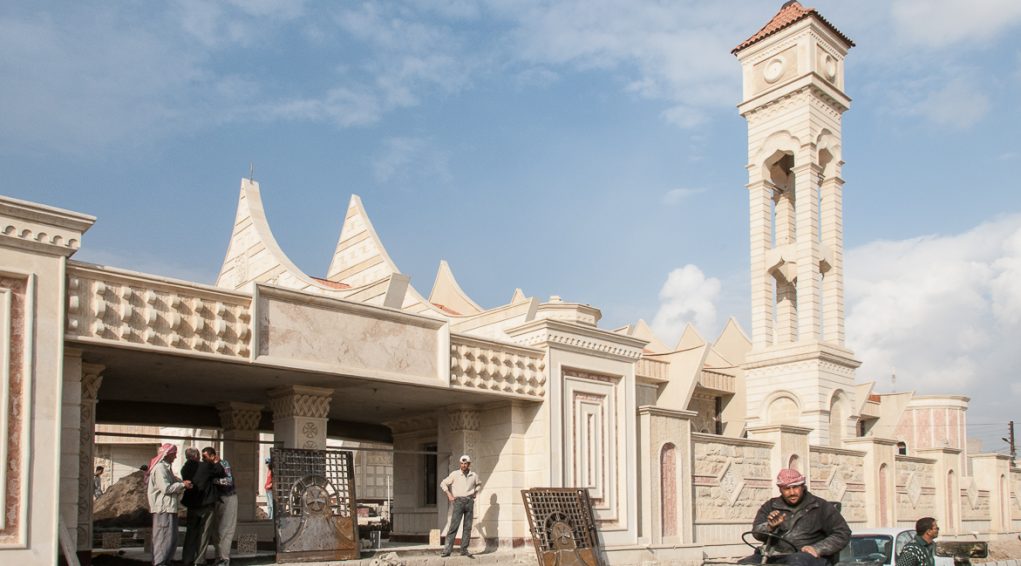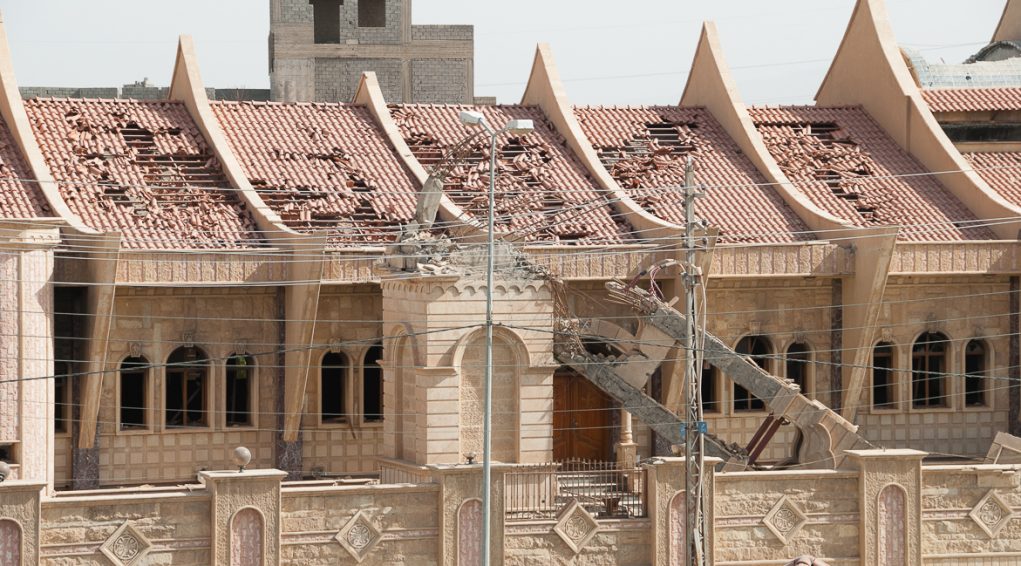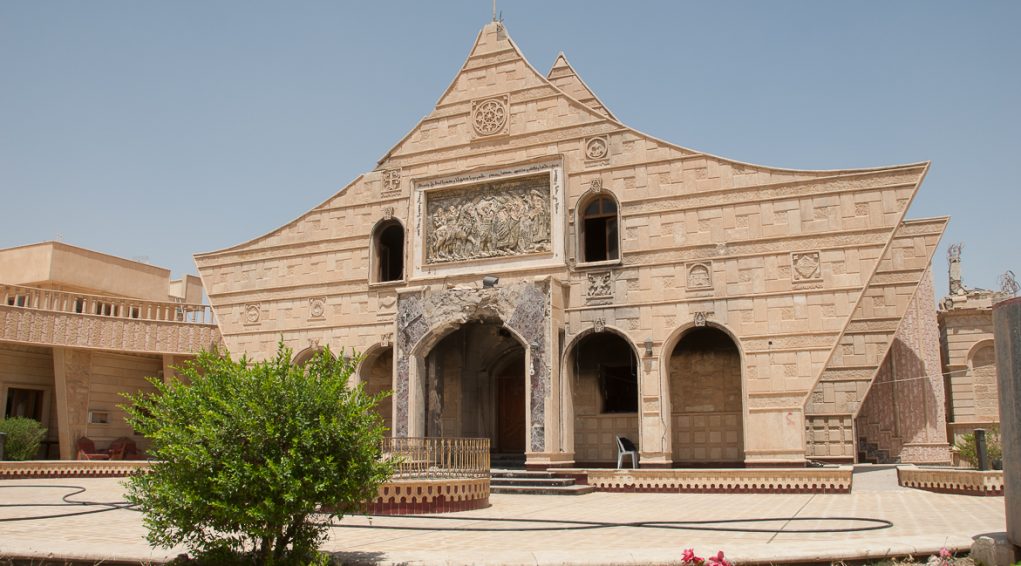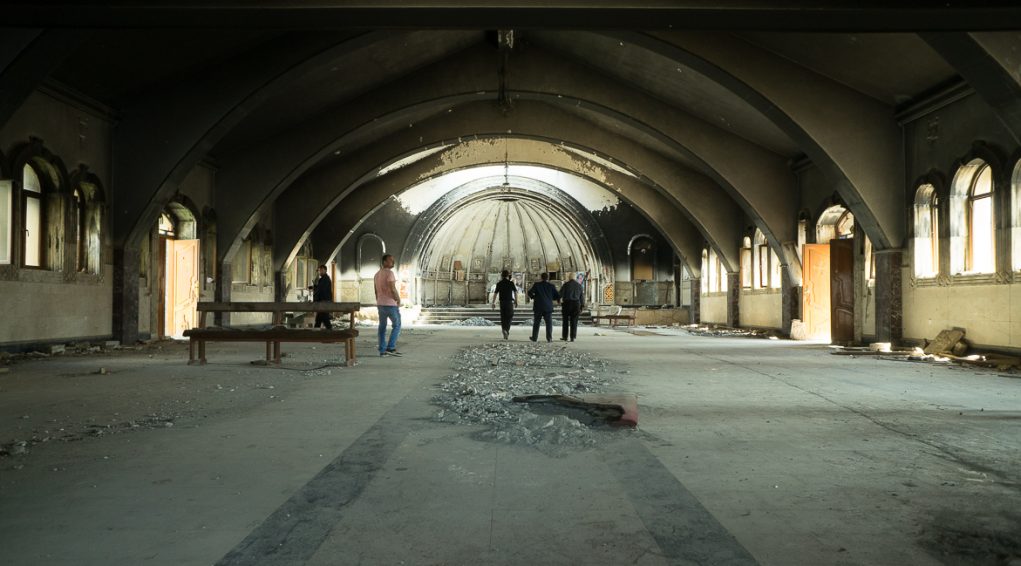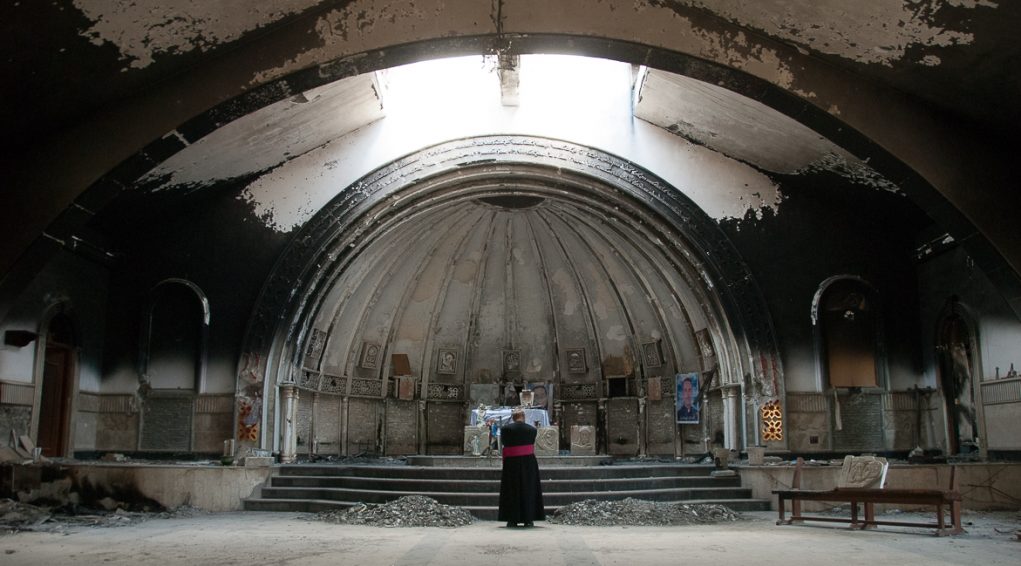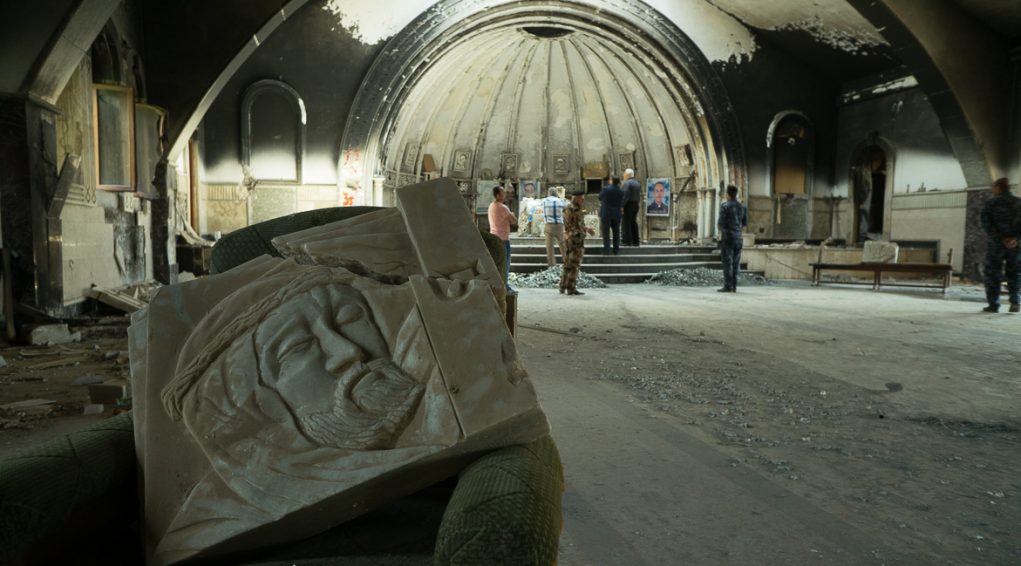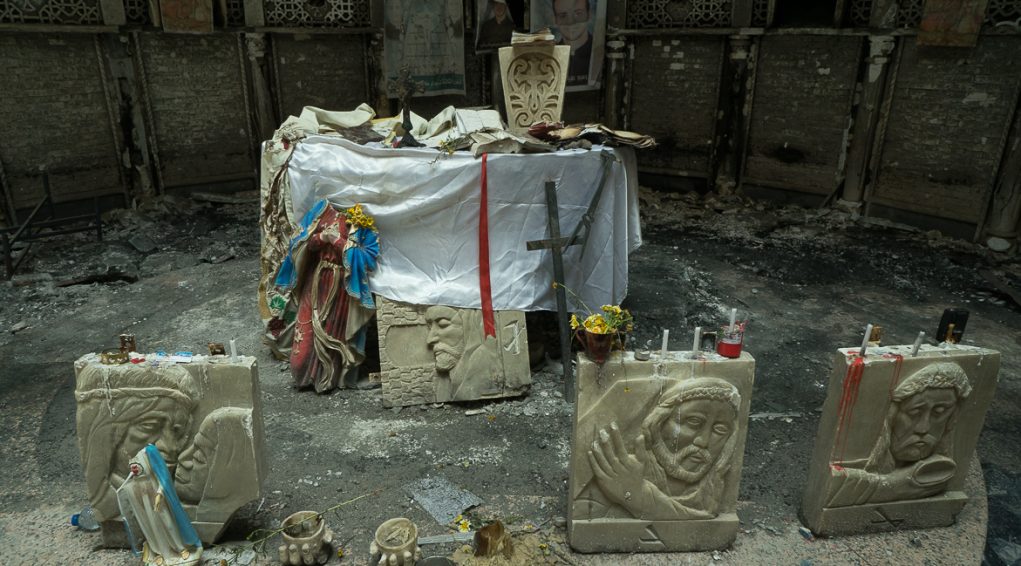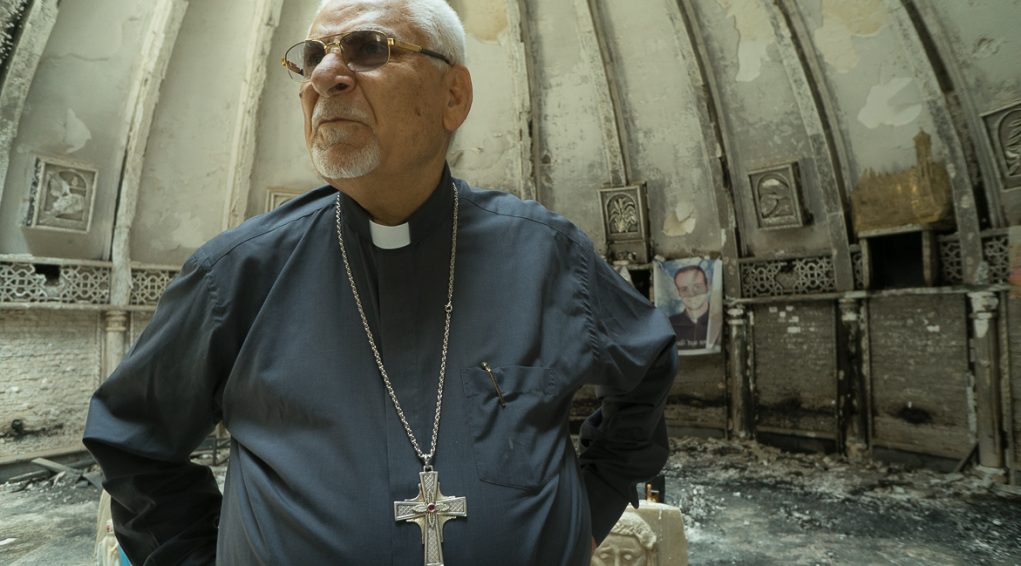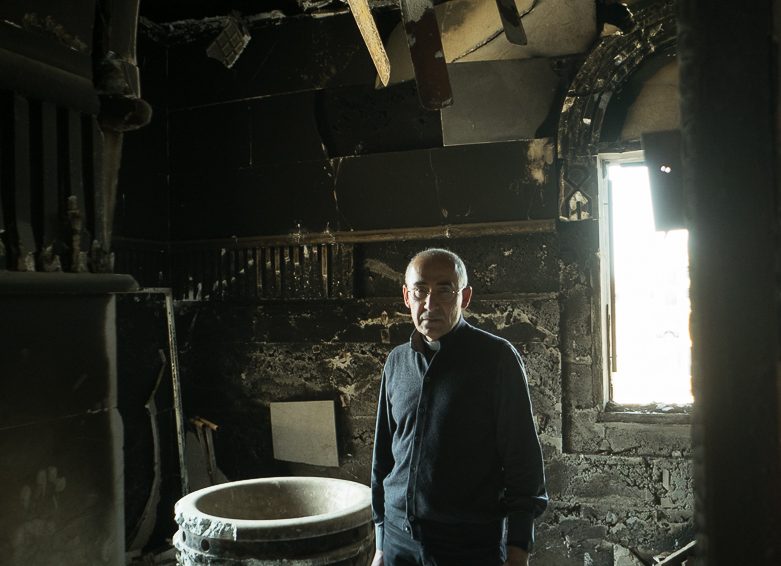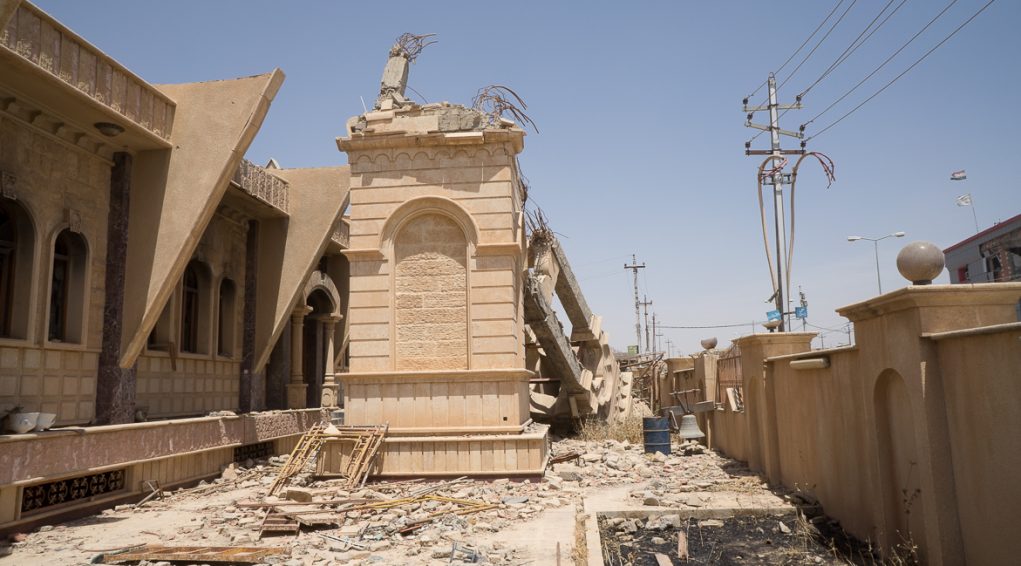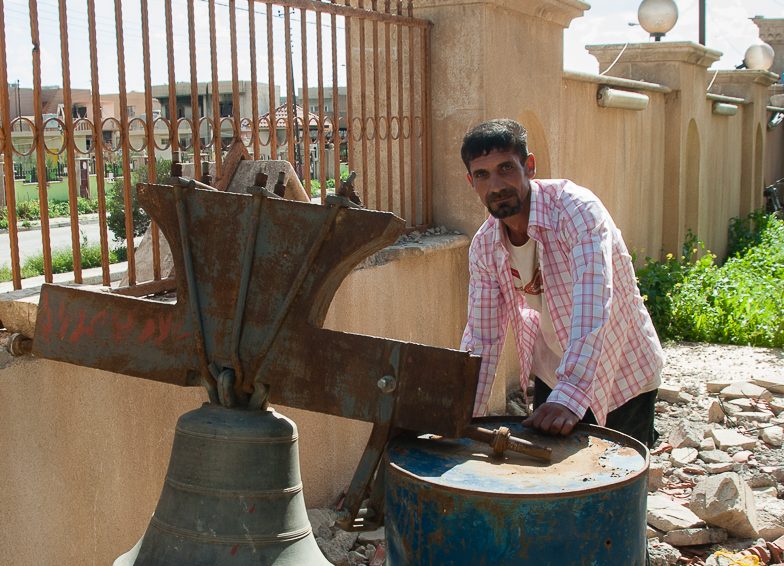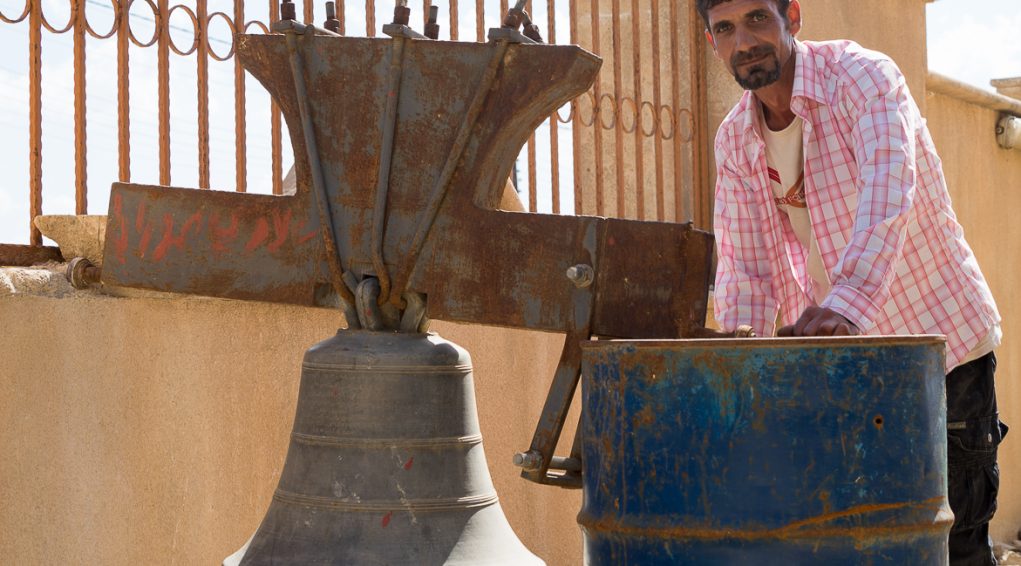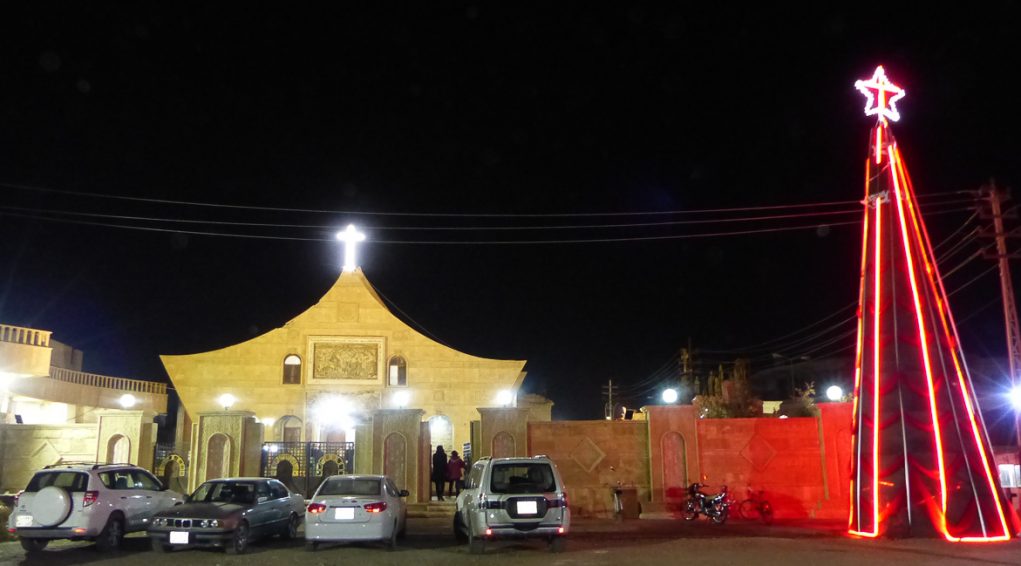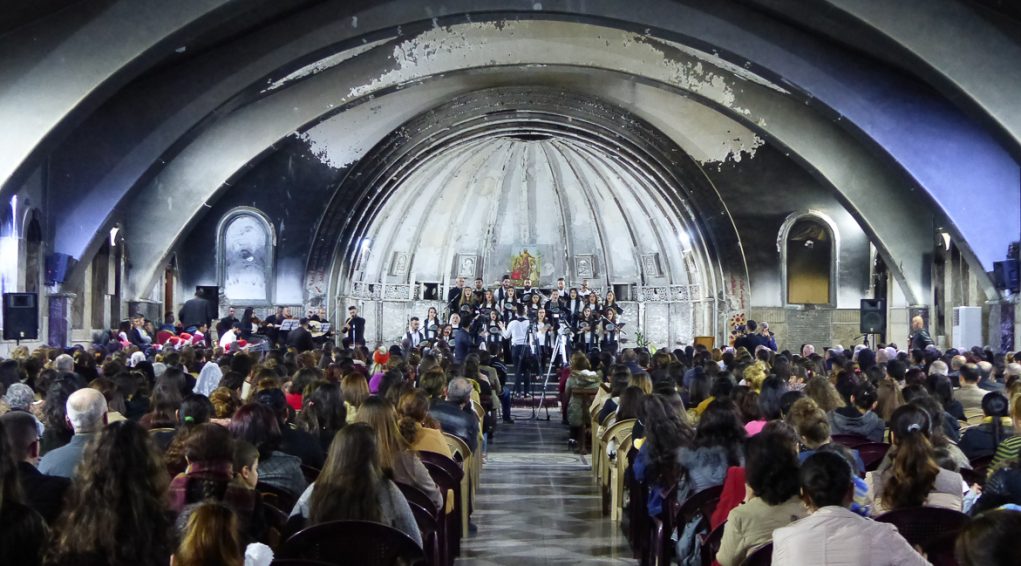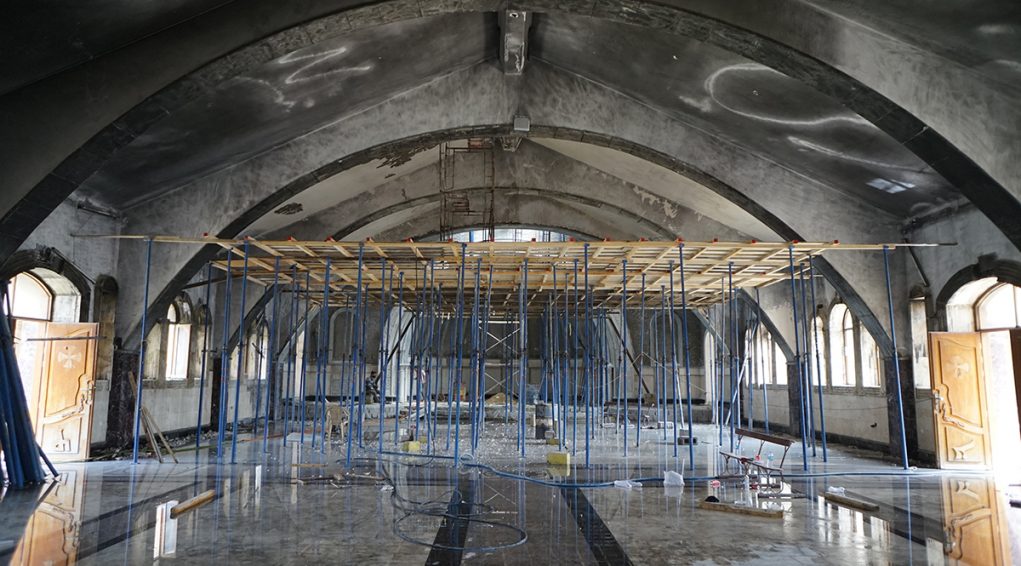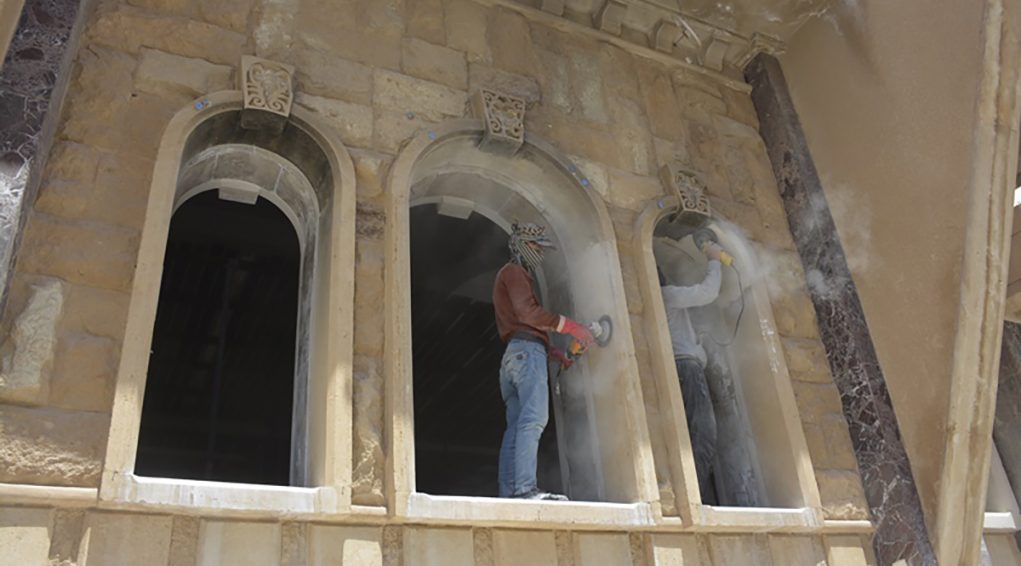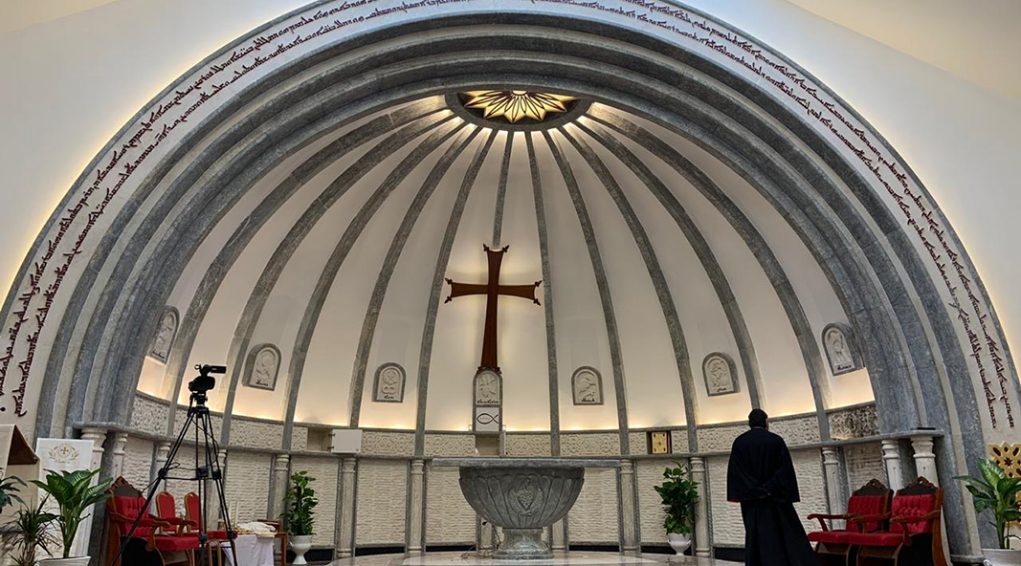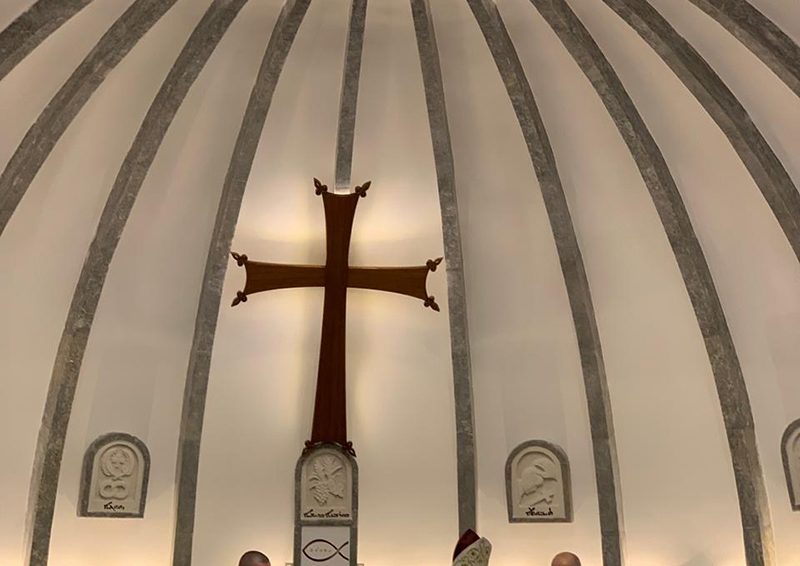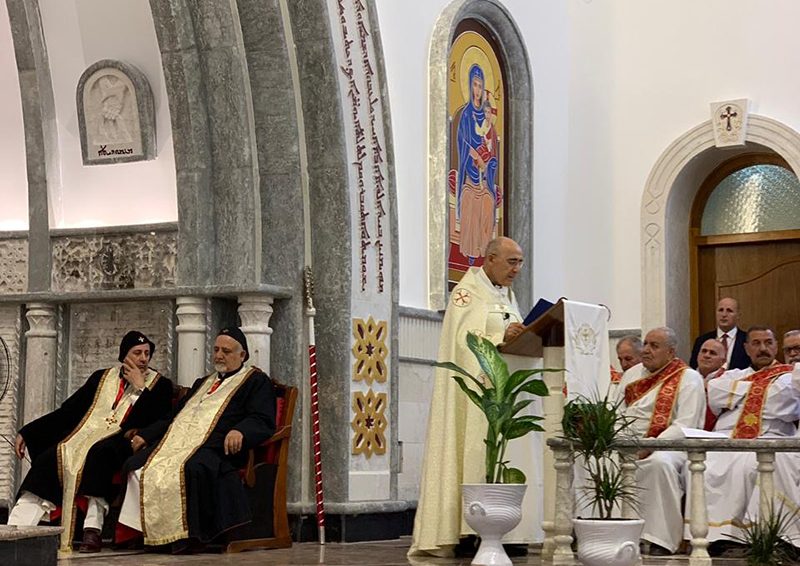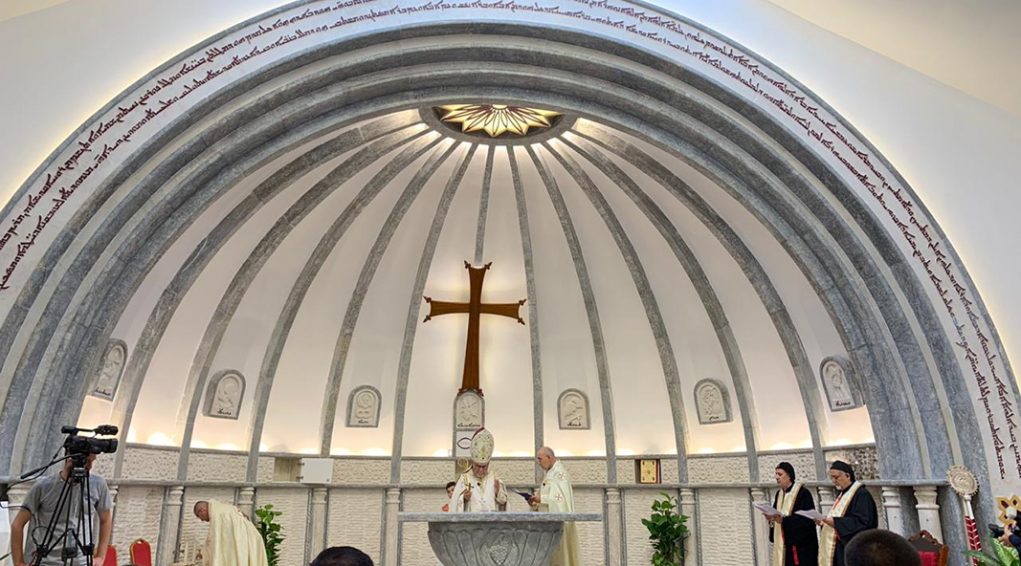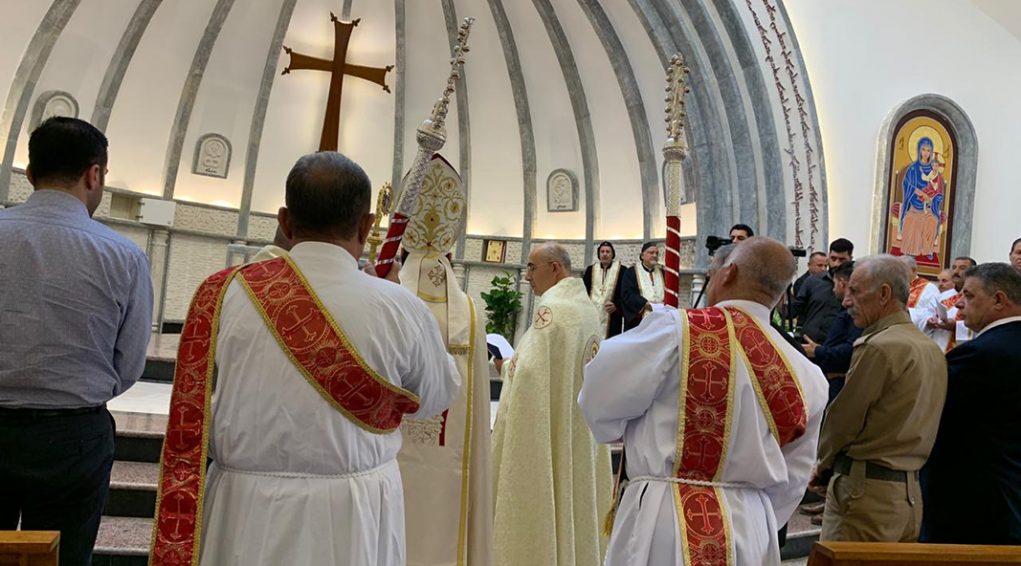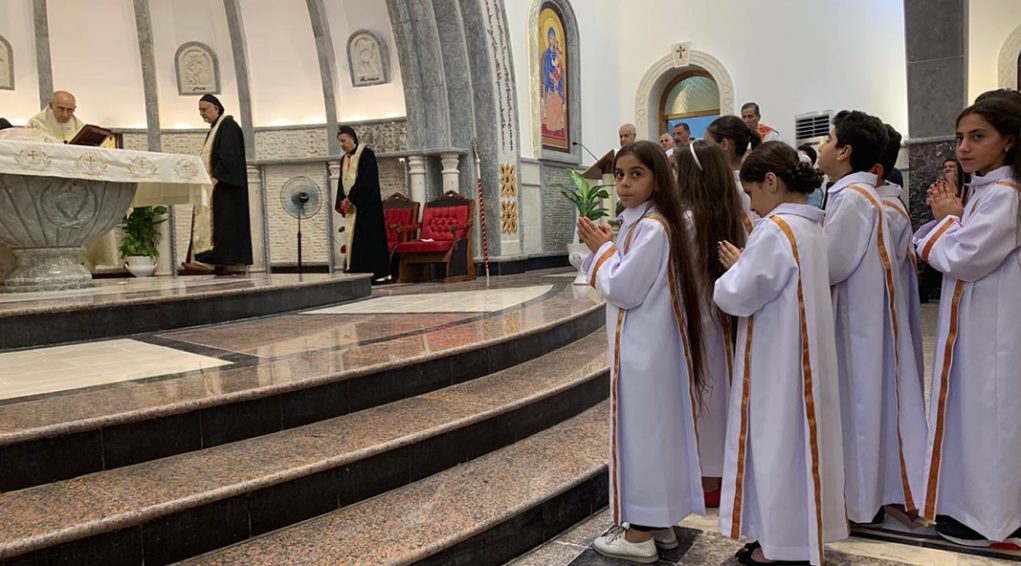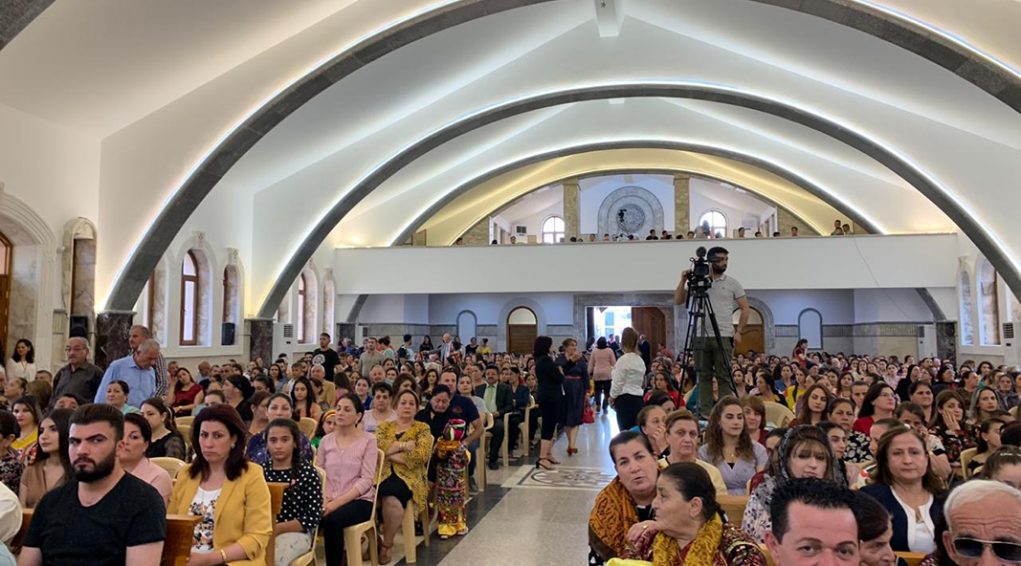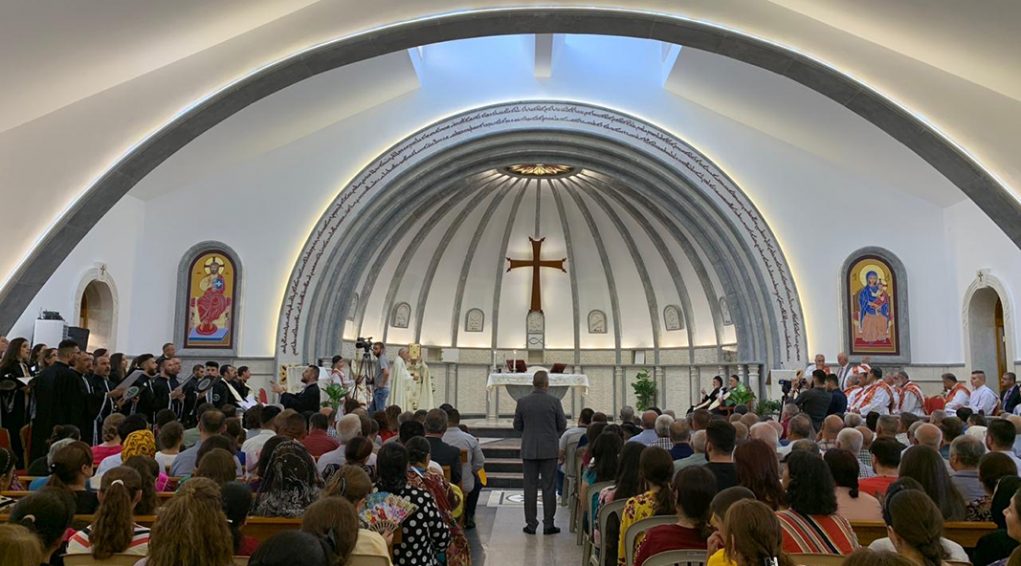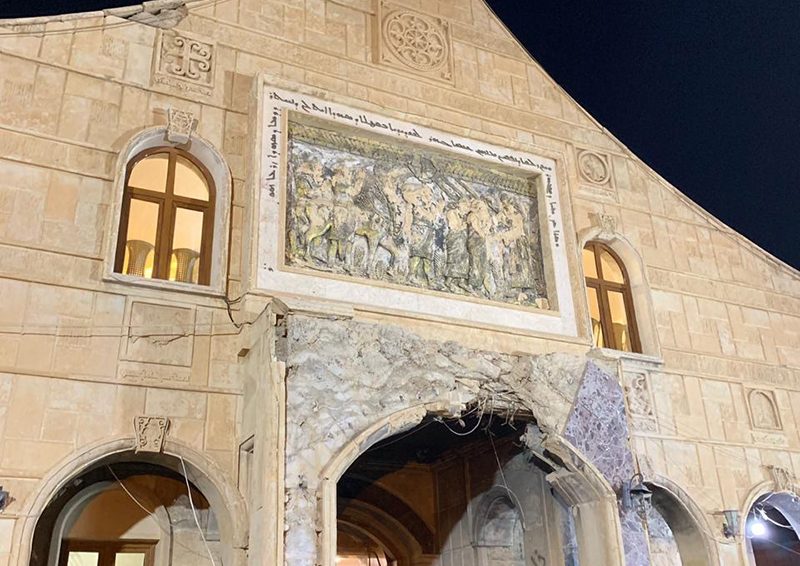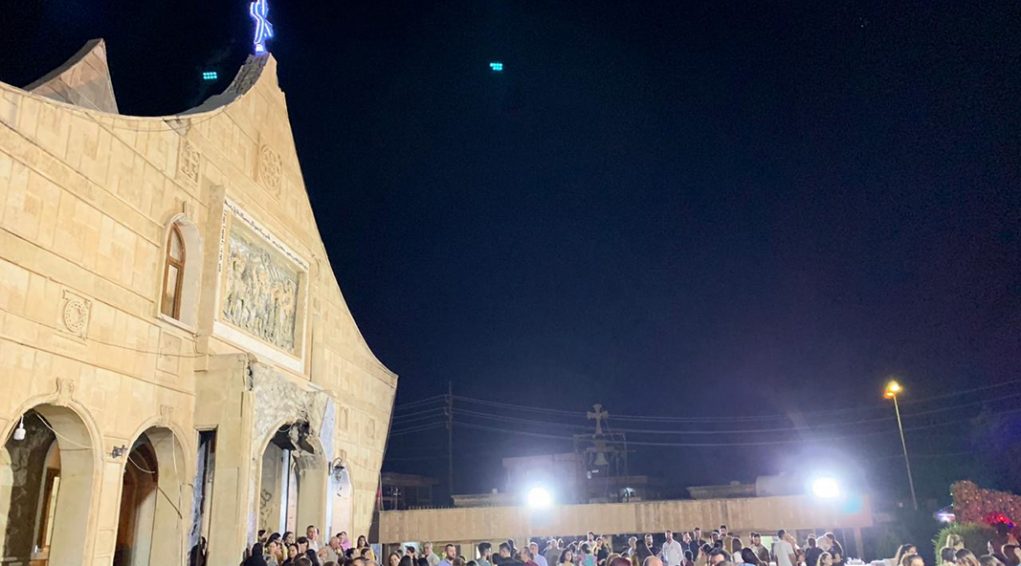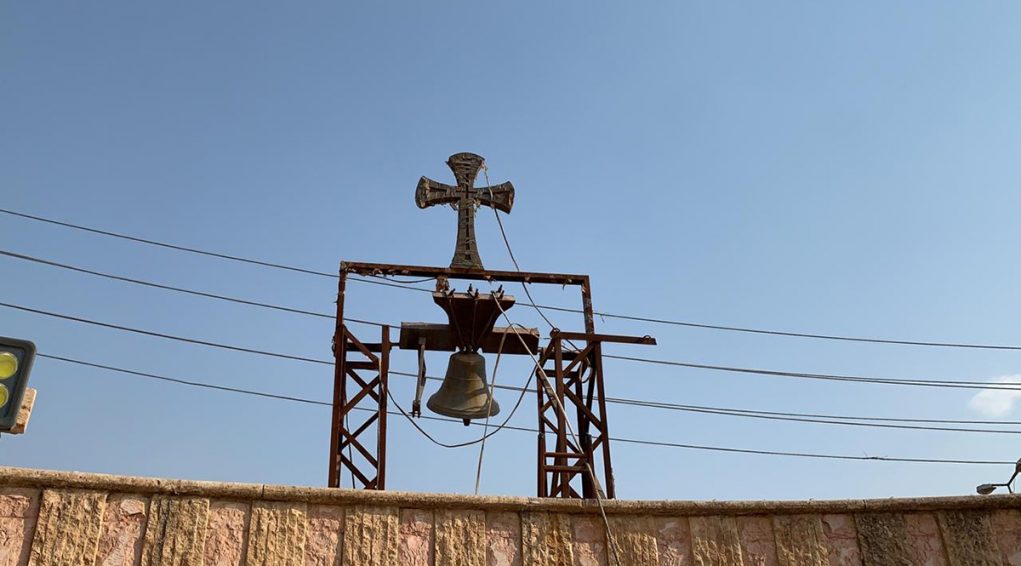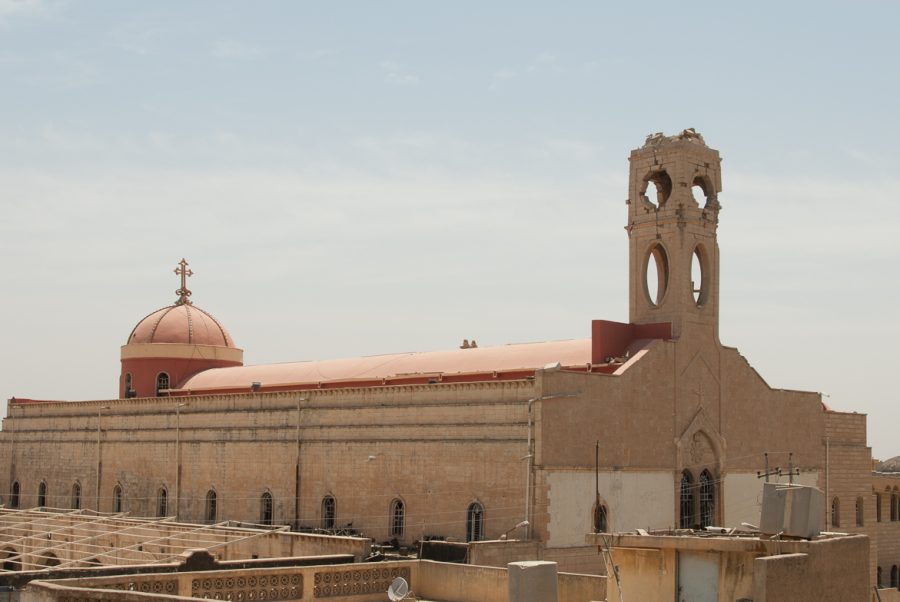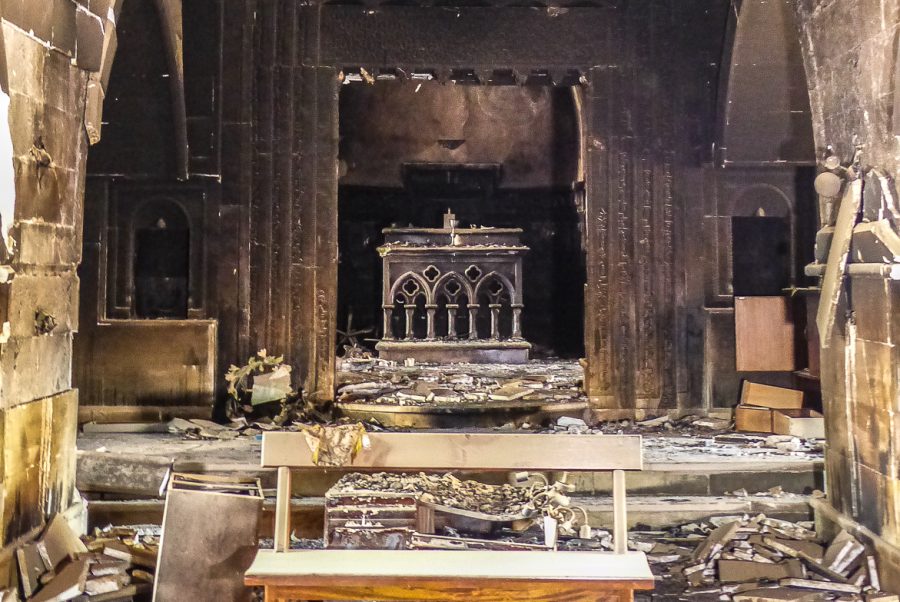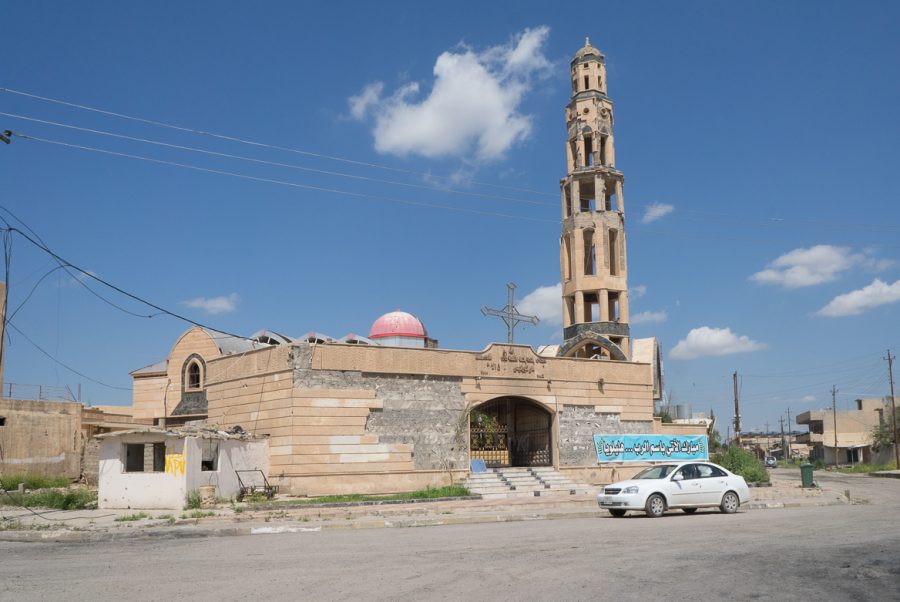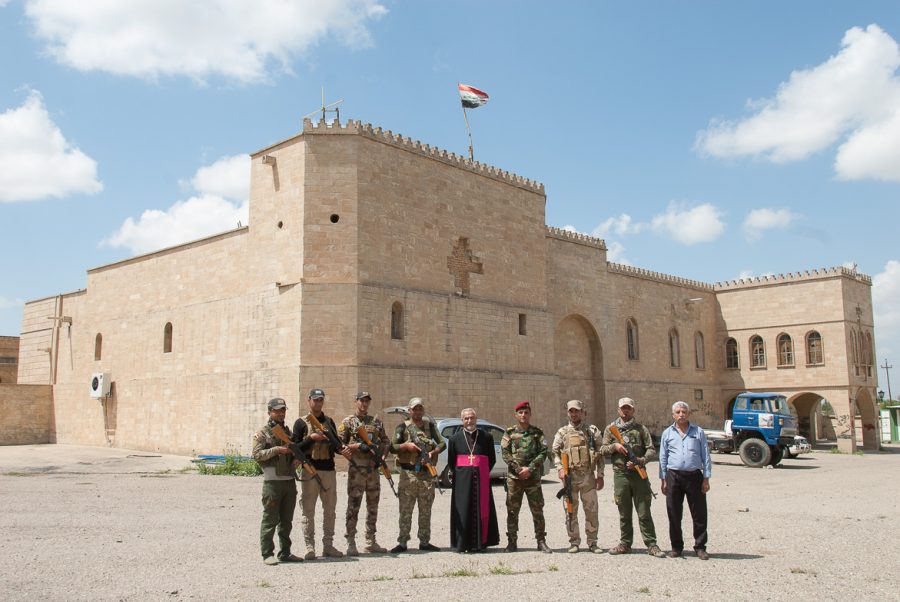The Church of Mar Behnām and Mart Sārah in Baghdede (Qaraqosh)
The church of Mar Behnām and Mart Sārah in Baghdede (Qaraqosh) lies 36°16’37.70″N 43°22’32.70″E and 275 metres high.
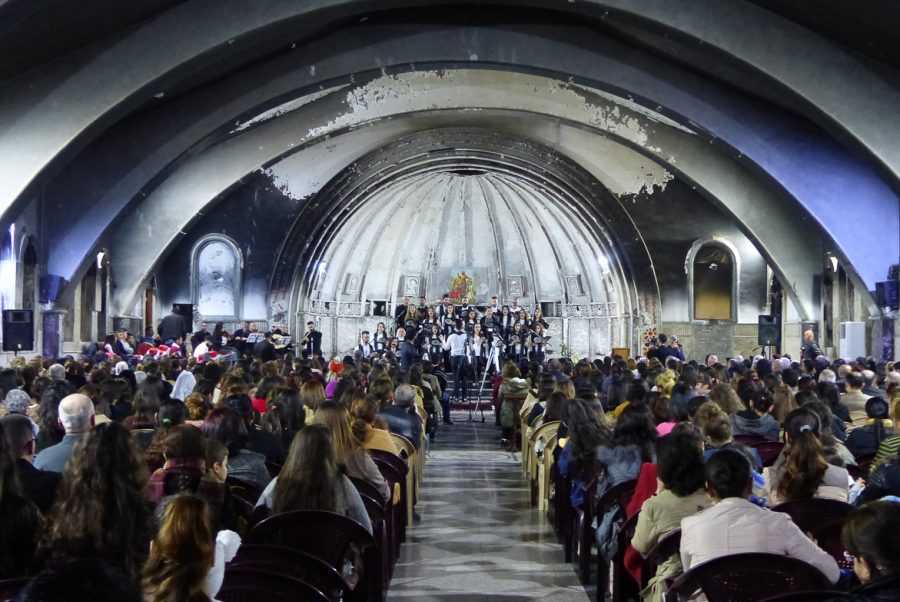
The church of Mar Behnām and Mart Sārah is the most recent Syriac Catholic place of worship in Baghdédé (Qaraqosh). It has been built from 2005 on and was consecrated on August 4th, 2008. The building is most impressive at first sight. Thanks to its daring arch shape, it has a most unusual type of architecture throughout Mesopotamia and would like to be a symbol of the Syriac Catholic vitality in Baghdédé (Qaraqosh) at the dawn of the 21stcentury and despite anti-Christian war and persecutions. Plundered and torched by ISIS, the church of Mar Behnām and Mart Sārah is nowadays being restored.
Location
The church of Mar Behnām and Mart Sārah lies 36°16’37.70″N, 43°22’32.70″E and 275 metres high, in the town centre of Baghdede (Qaraqosh). 30 km southeast from Mosul and 80 km west from Erbil, Baghdede is the greatest city of the Nineveh plain, in the Al Hamdaniya district, 40 km upstream from the confluence of the Tigris river and the Great Zab.
The name Qaraqosh, which in modern Turkish means Black Bird, is quite frequently used but its other and original name, Baghdede (Baghdeda) in Syriac language “probably comes from Bet Khudaydad which combines both semitic (Bet) and Persian (Khudaydad) origins [and which] means the place, the house given by God”[1]. This Syriac nameshould not be ignored as it seems to be the most in use nowadays.
In the heart of the well-named Syriac plains, Baghdeda enjoys renewed original and spiritual influence and takes its status as World capital for Syriac Catholics up again, as it used to be before ISIS attacked and all inhabitants fled overnight from August 6thto 7th2014. Since the town was liberated in October 2016 and the returning of many inhabitants from April 2017 on, Baghdeda is considered as an essential geographic pole for the Christian and Syriac revival in the Nineveh plain and throughout Mesopotamia.
_______
[1]Source Jean-Marie Mérigoux, O.P., in « L’Orient chrétien dans l’empire musulman », Collection Studia Arabica III, Editions de Paris, 2005.
A short Christian history of Baghdede
According to the tradition, Christianity entered the Nineveh plain and the city of Baghdede from the end of the 4thcentury or the beginning of the 5thcentury. More than likely, sources argue that evangelisation began in the 7thcentury. “The village was first Nestorian[1], then around 615 [it] became Monophysite[2]. In the 11thand 12thcentury, many Christians from Tikrit, before being forced to convert to Islam, left Tikrit and settled in Baghdeda. In 1743, Nader Shah’s troops besieged the area, plundered Baghdede and destroyed the churches.
At that time, the villagers escaped to Mosul and took part in the defence of the town”[3].
Former Syriac-Orthodox bishop see, the village became Catholic at the end of 18thcentury.
There are still several ancient Syriac-Catholic and Orthodox churches in nowadays Baghdede. All have been violated, sullied, plundered, even burnt by ISIS, all along the 24 months it occupied the city. Despite wreckages and destructions, some of these churches still stand firm against time and invaders and carry on being testament to this distant past.
_______
[3]Source Jean-Marie Mérigoux, O.P., in « L’Orient chrétien dans l’empire musulman », Collection Studia Arabica III, Editions de Paris, 2005.
A still visible Christian testament
Although the reliability of demographic statistics can be considered as a problem, due to successive wars, to never-ending mass movements of population and to the absence of proper census, nevertheless, we can admit that at least 40 000 to 50 000 people used to live in Baghdede before ISIS attacked in July 2014. Nearly 90 % of the inhabitants in Baghdede were Syriac-Catholics. The other 10 % were being split between Chaldeans (Catholic), Syriac-Orthodoxes, as well as apostolic Armenians. To this must be added thousands of displaced people, 5 000 to 13 000 – depending on the different phases – Christian people, mostly coming from Baghdad or Mosul who came to settle in Baghdede from 2003 on. All were running away from crimes and misdemeanours committed by the terrorist or mafia groups that appeared after the Iraqi state collapsed.
Before 1980, this city was said to be exclusively Christian. But afterwards, Muslim families progressively settled in, as part of the campaign of Arabisation of the Nineveh plain set up by Saddam Hussein.
A short hagyography of Mar Behnām and Mart Sārah
The life of Mar Behnām and Mart Sārah is reported in the Chroniclewritten by of a monk from Edessa (Urfa, in Turkey) in the 12th-13thcentury[1]. According to that Chronicle, Princess Sārah, sister of Prince Behnām, was healed from leprosy by Mar Mattai (Saint Matthew), on the spot of a miraculous water spring. Healing both flesh and soul, as the holy monk converted both children and christened them at once. Their father was the king of Nimrūd, Sinharib II, and he went mad with anger with this conversion, the Assyrian king had the children killed, together with their 40 slaves of the princely suite. Behnām and Sārah, martyred saints were probably of Persian origin and could have lived in the 4thcentury if we consider the tradition as reliable ; however they also could have lived in the 5thor 6thcentury, without much more precision, as we lack reliable historical sources. The tradition also relates that the Queen Širīn “had a 7-km long tunnel dug between her place and the martyrion”, so that she could go and cry at her ease on her children’s grave. She eventually succeeded in converting her husband, “exorcised by Mar Matta”[2] .
Even nowadays, « everybody, the Christians who live in the sphere of influence of the monastery, as well as the Arabs from around Nimrūd, was absolutely convinced in the existence of this tunnel, and that the find of any hole is hailed as the discovery of the tunnel’s entrance (…) »[3].
That is how was established and transmitted, throughout the centuries and until nowadays, the fabulous epic of Assyria’s conversion to Christianity.
The beautiful monastery of Mar Behnām and Mart Sārah, located in Khdir, very close to Baghdede is, according to the tradition, the place of the original martyrium. Mar Behnām has been venerated for centuries by a huge number of Christian Syriac-speaking visitors, but also by muslims or yazidis, and more especially women who come to ask the saint’s intercession to get abundance and fertility. This shrine could have been built on the place of a primitive church.
The building of a church dedicated to Behnām and Sārah in Baghdede is the symbol of the revival of a faith, deeply ingrained in the flesh and soul of Iraqi Christians for the past 16 centuries.
________
[1]Quoted in Assyrie Chrétienne, Jean-Maurice Fiey, Institut de lettres orientales, Beyrouth, 1965-1968.
The church of Mar Behnām and Sārah
Amongst all the Christian buildings in Baghdede, the church of Mar Behnām and Sārah is the most recent. Raised along one of the busiest roads of the town, the church is an example of modern architecture, breaking up deliberately with the traditional architecture standards for churches in Mesopotamia.
Mar Behnām and Sārah Monastery, in Khdir, is a masterpiece of ancient Christian art, combining Assyrian sources, muslim Atabeg style from the 12thcentury, and Armenian-styled stone laces. On the contrary, the church of Mar Behnām and Sārah presents a completely unusual type of architecture and still unclassifiable. Whereas the first one sublimates ancestral roots, the second one glorifies the future.
The building of Mar Behnām and Sārah church started in 2005 and it was consecrated on August 4th2008. Just like for the new Al Tahira[1]church in Baghdede, the building of this new church rallied large numbers of inhabitants and workers in the great Christian city. Through this enthusiasm, the building of Mar Behnām and Sārah is a symbol of the Syriac-Catholic vitality of Baghdede at the dawn of the 21stcentury, despite wars and anti-Christian persecutions committed by armed jihadist groups.
The religious compound of the church is closed by a wall and a gate, which have no protection nor defence aims, unlike other surrounding walls, usually high and massive to protect places of worship.
The building is impressive at first sight. Its daring arch-shaped architecture is totally unprecedented in the Syriac world. Some see also a sort of tent of brotherhood in it. From the outside, 9 large curved arches run along the tiled roof and seem to bear gracefully the whole of the building.
Inside, the vault’s weight does not rest on pillars, as it usually does, but on round arches, leading all forces towards the load-bearing side walls.
The structure is made of reinforced concrete, covered with light ochre stone tiles. The pediment is ornamented with a large rectangle-shaped bas-relief, probably out of stucco, covered with a bronze-looking paint.
This fresco features the christening of Behnām and Sārah by Mar Mattai, it has been hammered out by the jihadist occupiers between 2014 and 2016.
The church is bathed with light thanks to a large number of windows in the side walls. The inner structure of the building shows a large hall, leading to a big slightly raised choir, totally open with no door nor curtains. The choir is round-shaped and covered by a spiral vault with 12 niches. At the very centre of the platform, behind the altar, a large ambulatory has been arranged. The baptistery, immediately on the right when you get in, has been completely damaged by the profaners. The church has been torched and plundered. The marble Stations of the Cross have been wrecked, just like all the liturgical pieces of furniture.
The bell tower raised on the southern side of the building has been collapsed down. Fortunately, the bell has been ringing again since the town was liberated. The restoration works are going on.
_______
News about Mar Behnam and Mart Sarah Church from Baghdede (Qaraqosh)
The restored church of Mar Behnam and Mart Sarah of Baghdede was inaugurated on August 15, 2019, the day of the feast of the Assumption.
The Restoration Committee started the interior works in March 2019, under the supervision of Abed al Aziz and Jerjis Mousa, with the financial support of CAPNI and L’Oeuvre d’Orient.
Monument's gallery
Monuments
Nearby
Help us preserve the monuments' memory
Family pictures, videos, records, share your documents to make the site live!
I contribute
